Operations and Project Management: A Case Study of Leyland Trucks and DAF
VerifiedAdded on 2024/05/31
|21
|4230
|191
AI Summary
This report examines the implementation of operations management principles within the context of Leyland Trucks Limited and DAF, subsidiaries of Paccar Inc. It analyzes the application of Lean manufacturing and Six Sigma methodologies to enhance efficiency. The report further develops a continuous improvement plan, including a work breakdown structure and Gantt chart, and evaluates the effectiveness of the project life cycle in achieving organizational goals. The analysis utilizes relevant theories, concepts, and models to provide a comprehensive understanding of operations and project management practices within the context of the case study.
Contribute Materials
Your contribution can guide someone’s learning journey. Share your
documents today.
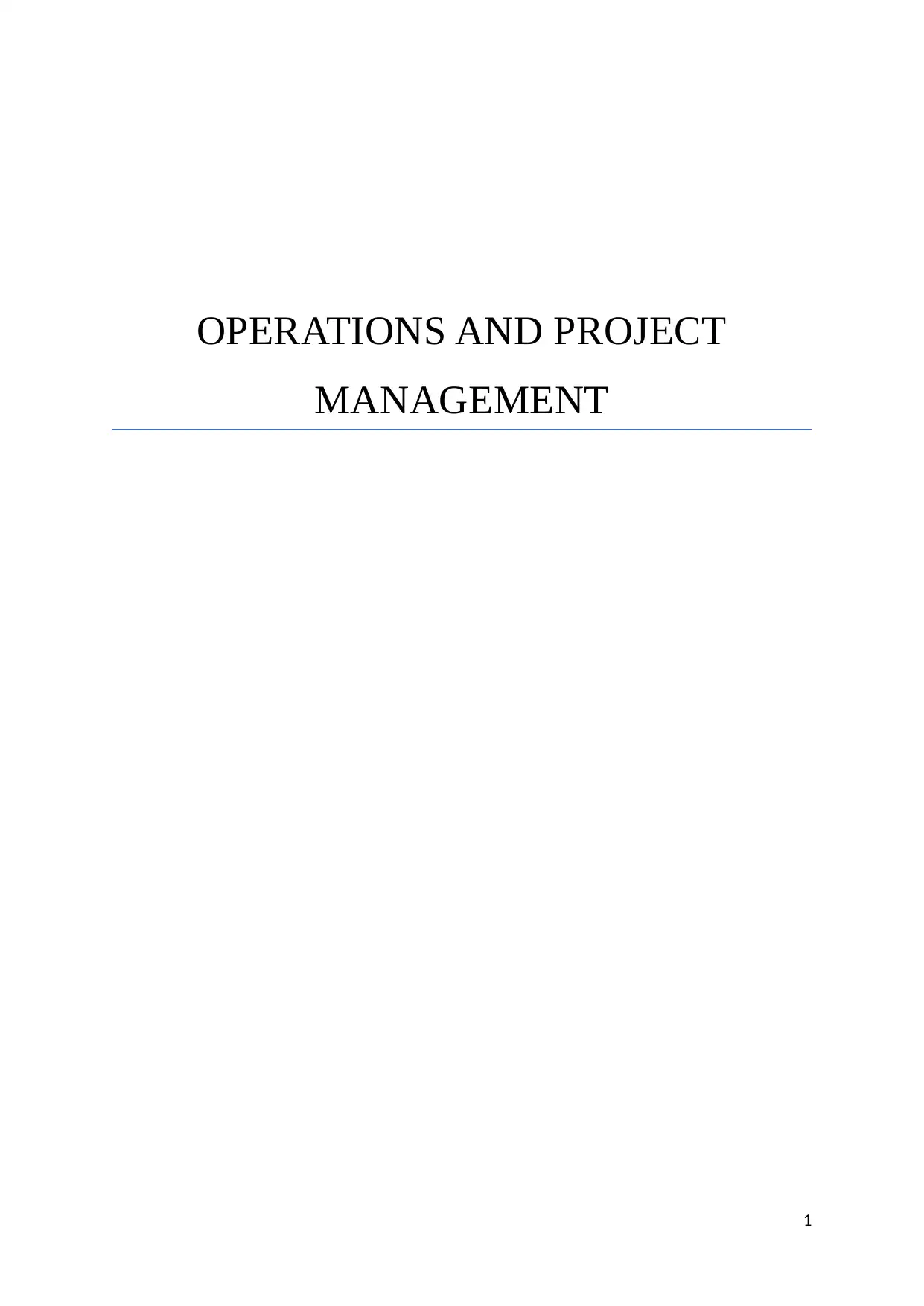
OPERATIONS AND PROJECT
MANAGEMENT
1
MANAGEMENT
1
Secure Best Marks with AI Grader
Need help grading? Try our AI Grader for instant feedback on your assignments.
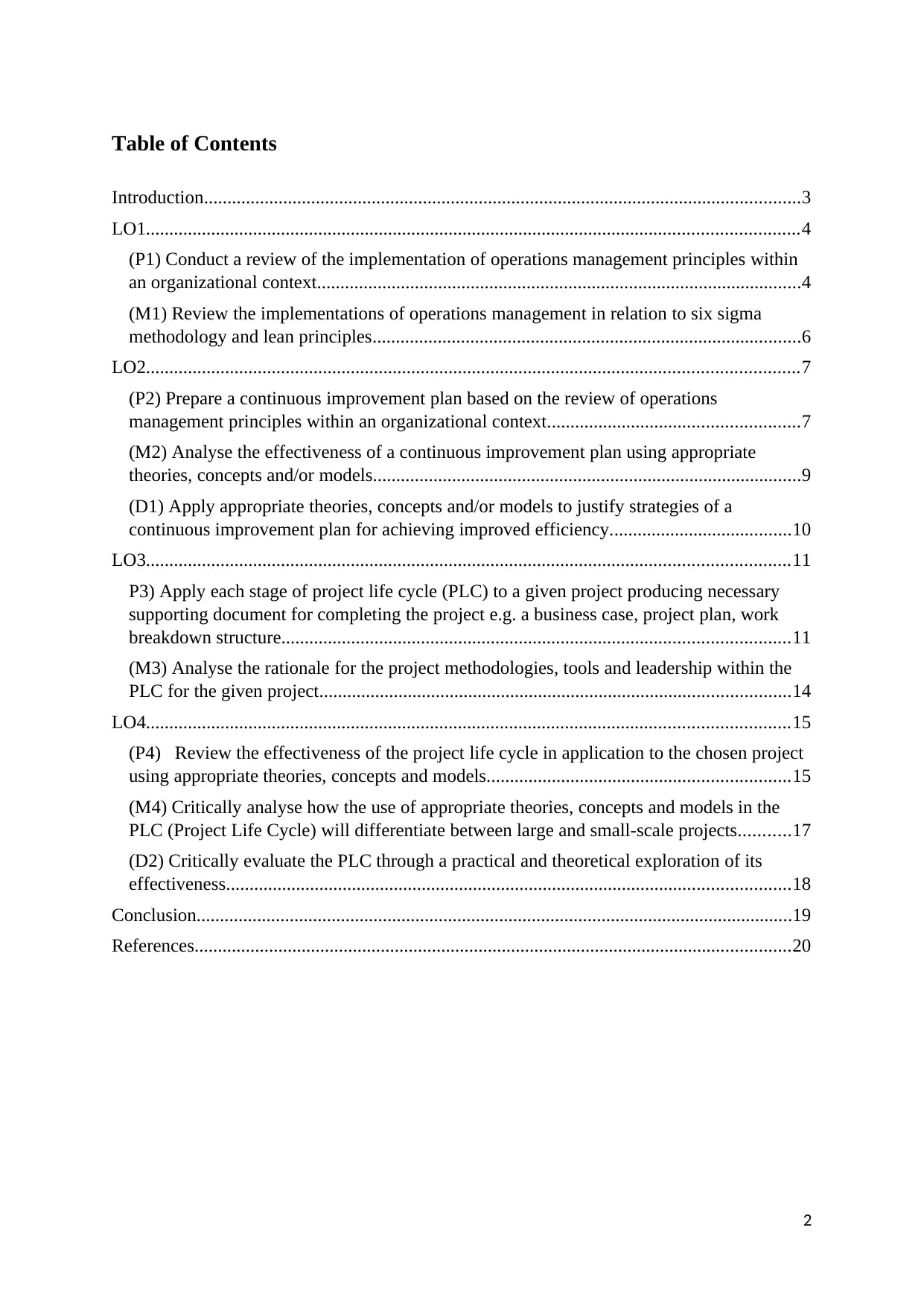
Table of Contents
Introduction................................................................................................................................3
LO1............................................................................................................................................4
(P1) Conduct a review of the implementation of operations management principles within
an organizational context........................................................................................................4
(M1) Review the implementations of operations management in relation to six sigma
methodology and lean principles............................................................................................6
LO2............................................................................................................................................7
(P2) Prepare a continuous improvement plan based on the review of operations
management principles within an organizational context......................................................7
(M2) Analyse the effectiveness of a continuous improvement plan using appropriate
theories, concepts and/or models............................................................................................9
(D1) Apply appropriate theories, concepts and/or models to justify strategies of a
continuous improvement plan for achieving improved efficiency.......................................10
LO3..........................................................................................................................................11
P3) Apply each stage of project life cycle (PLC) to a given project producing necessary
supporting document for completing the project e.g. a business case, project plan, work
breakdown structure.............................................................................................................11
(M3) Analyse the rationale for the project methodologies, tools and leadership within the
PLC for the given project.....................................................................................................14
LO4..........................................................................................................................................15
(P4) Review the effectiveness of the project life cycle in application to the chosen project
using appropriate theories, concepts and models.................................................................15
(M4) Critically analyse how the use of appropriate theories, concepts and models in the
PLC (Project Life Cycle) will differentiate between large and small-scale projects...........17
(D2) Critically evaluate the PLC through a practical and theoretical exploration of its
effectiveness.........................................................................................................................18
Conclusion................................................................................................................................19
References................................................................................................................................20
2
Introduction................................................................................................................................3
LO1............................................................................................................................................4
(P1) Conduct a review of the implementation of operations management principles within
an organizational context........................................................................................................4
(M1) Review the implementations of operations management in relation to six sigma
methodology and lean principles............................................................................................6
LO2............................................................................................................................................7
(P2) Prepare a continuous improvement plan based on the review of operations
management principles within an organizational context......................................................7
(M2) Analyse the effectiveness of a continuous improvement plan using appropriate
theories, concepts and/or models............................................................................................9
(D1) Apply appropriate theories, concepts and/or models to justify strategies of a
continuous improvement plan for achieving improved efficiency.......................................10
LO3..........................................................................................................................................11
P3) Apply each stage of project life cycle (PLC) to a given project producing necessary
supporting document for completing the project e.g. a business case, project plan, work
breakdown structure.............................................................................................................11
(M3) Analyse the rationale for the project methodologies, tools and leadership within the
PLC for the given project.....................................................................................................14
LO4..........................................................................................................................................15
(P4) Review the effectiveness of the project life cycle in application to the chosen project
using appropriate theories, concepts and models.................................................................15
(M4) Critically analyse how the use of appropriate theories, concepts and models in the
PLC (Project Life Cycle) will differentiate between large and small-scale projects...........17
(D2) Critically evaluate the PLC through a practical and theoretical exploration of its
effectiveness.........................................................................................................................18
Conclusion................................................................................................................................19
References................................................................................................................................20
2
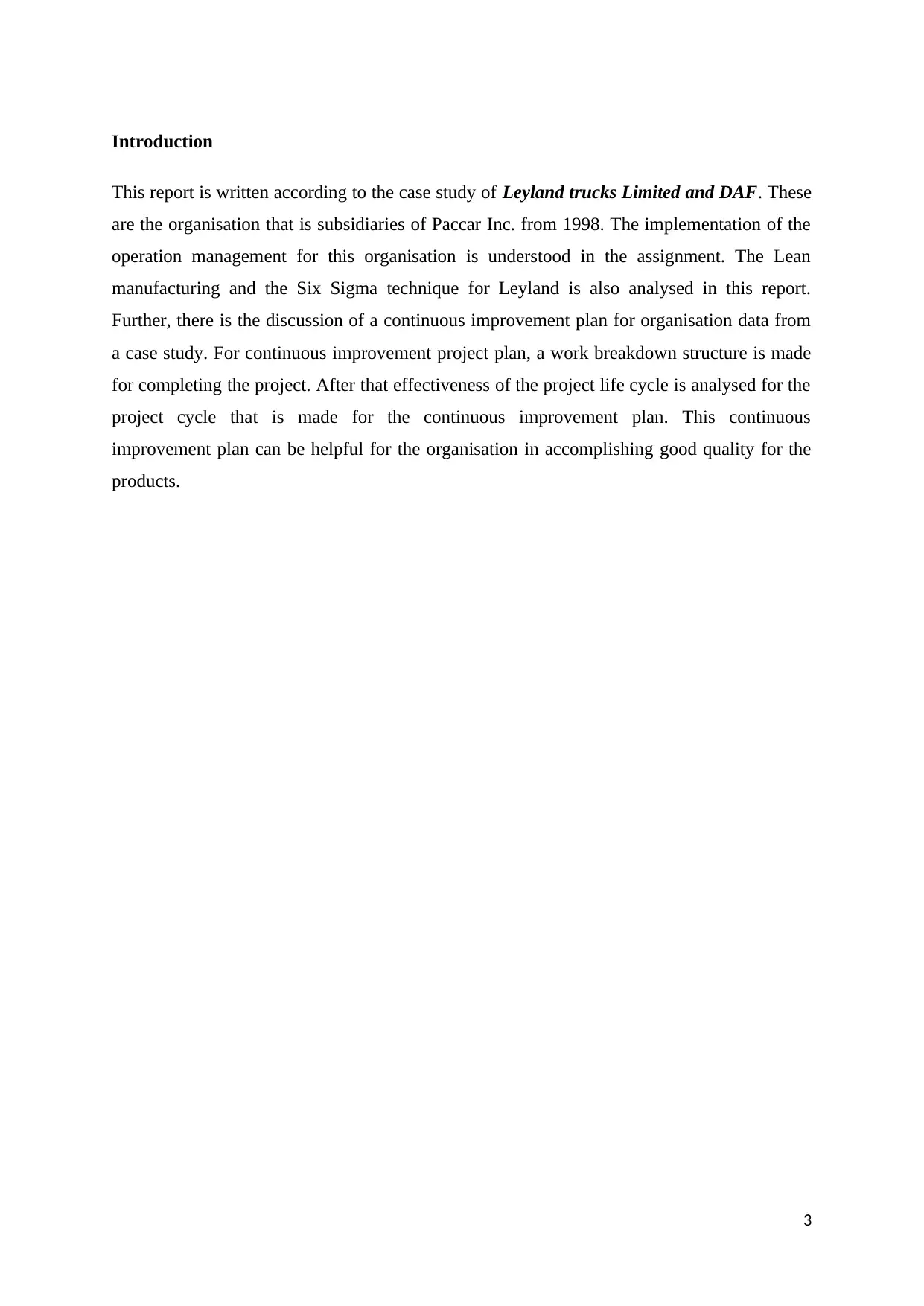
Introduction
This report is written according to the case study of Leyland trucks Limited and DAF. These
are the organisation that is subsidiaries of Paccar Inc. from 1998. The implementation of the
operation management for this organisation is understood in the assignment. The Lean
manufacturing and the Six Sigma technique for Leyland is also analysed in this report.
Further, there is the discussion of a continuous improvement plan for organisation data from
a case study. For continuous improvement project plan, a work breakdown structure is made
for completing the project. After that effectiveness of the project life cycle is analysed for the
project cycle that is made for the continuous improvement plan. This continuous
improvement plan can be helpful for the organisation in accomplishing good quality for the
products.
3
This report is written according to the case study of Leyland trucks Limited and DAF. These
are the organisation that is subsidiaries of Paccar Inc. from 1998. The implementation of the
operation management for this organisation is understood in the assignment. The Lean
manufacturing and the Six Sigma technique for Leyland is also analysed in this report.
Further, there is the discussion of a continuous improvement plan for organisation data from
a case study. For continuous improvement project plan, a work breakdown structure is made
for completing the project. After that effectiveness of the project life cycle is analysed for the
project cycle that is made for the continuous improvement plan. This continuous
improvement plan can be helpful for the organisation in accomplishing good quality for the
products.
3
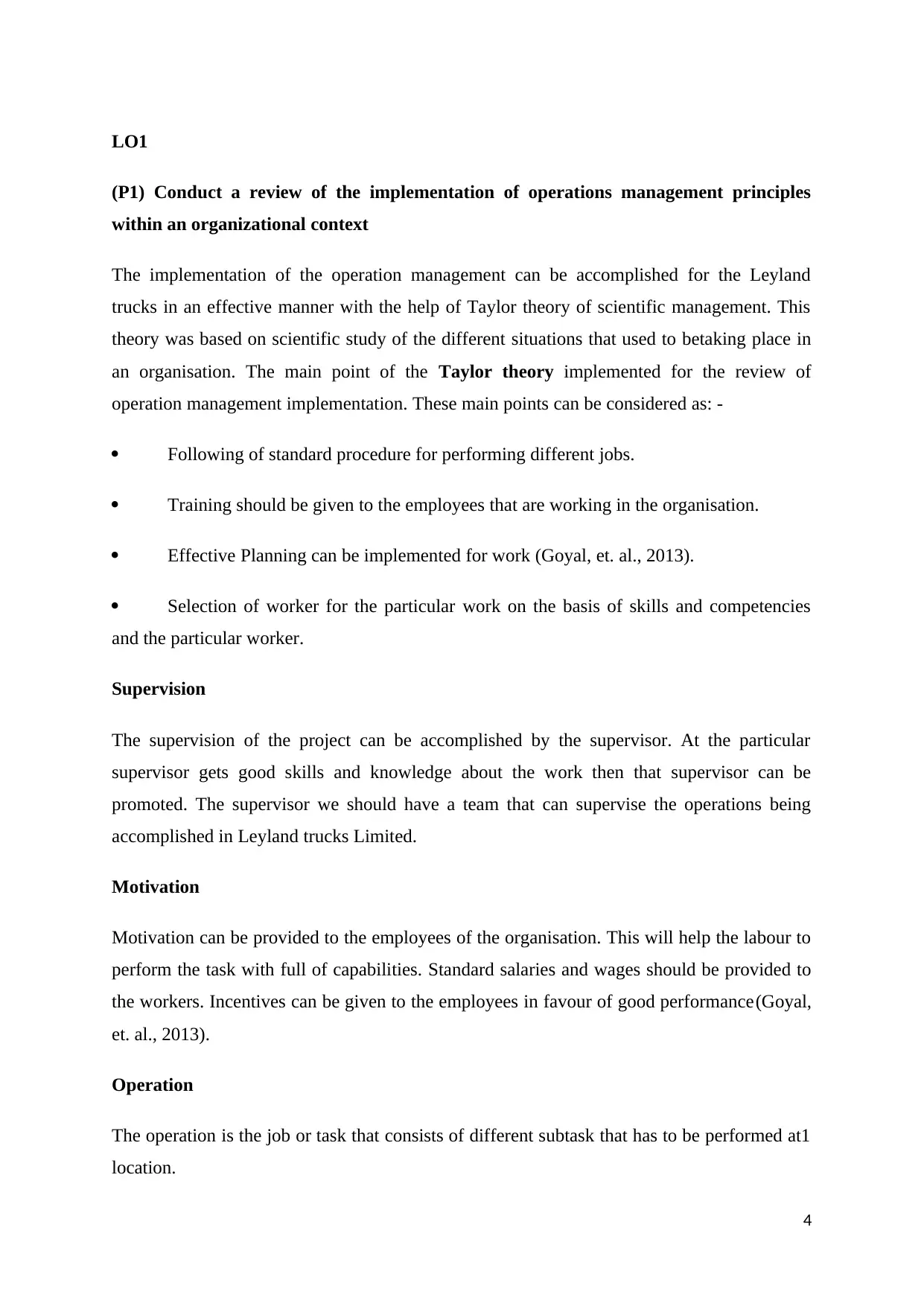
LO1
(P1) Conduct a review of the implementation of operations management principles
within an organizational context
The implementation of the operation management can be accomplished for the Leyland
trucks in an effective manner with the help of Taylor theory of scientific management. This
theory was based on scientific study of the different situations that used to betaking place in
an organisation. The main point of the Taylor theory implemented for the review of
operation management implementation. These main points can be considered as: -
Following of standard procedure for performing different jobs.
Training should be given to the employees that are working in the organisation.
Effective Planning can be implemented for work (Goyal, et. al., 2013).
Selection of worker for the particular work on the basis of skills and competencies
and the particular worker.
Supervision
The supervision of the project can be accomplished by the supervisor. At the particular
supervisor gets good skills and knowledge about the work then that supervisor can be
promoted. The supervisor we should have a team that can supervise the operations being
accomplished in Leyland trucks Limited.
Motivation
Motivation can be provided to the employees of the organisation. This will help the labour to
perform the task with full of capabilities. Standard salaries and wages should be provided to
the workers. Incentives can be given to the employees in favour of good performance(Goyal,
et. al., 2013).
Operation
The operation is the job or task that consists of different subtask that has to be performed at1
location.
4
(P1) Conduct a review of the implementation of operations management principles
within an organizational context
The implementation of the operation management can be accomplished for the Leyland
trucks in an effective manner with the help of Taylor theory of scientific management. This
theory was based on scientific study of the different situations that used to betaking place in
an organisation. The main point of the Taylor theory implemented for the review of
operation management implementation. These main points can be considered as: -
Following of standard procedure for performing different jobs.
Training should be given to the employees that are working in the organisation.
Effective Planning can be implemented for work (Goyal, et. al., 2013).
Selection of worker for the particular work on the basis of skills and competencies
and the particular worker.
Supervision
The supervision of the project can be accomplished by the supervisor. At the particular
supervisor gets good skills and knowledge about the work then that supervisor can be
promoted. The supervisor we should have a team that can supervise the operations being
accomplished in Leyland trucks Limited.
Motivation
Motivation can be provided to the employees of the organisation. This will help the labour to
perform the task with full of capabilities. Standard salaries and wages should be provided to
the workers. Incentives can be given to the employees in favour of good performance(Goyal,
et. al., 2013).
Operation
The operation is the job or task that consists of different subtask that has to be performed at1
location.
4
Paraphrase This Document
Need a fresh take? Get an instant paraphrase of this document with our AI Paraphraser
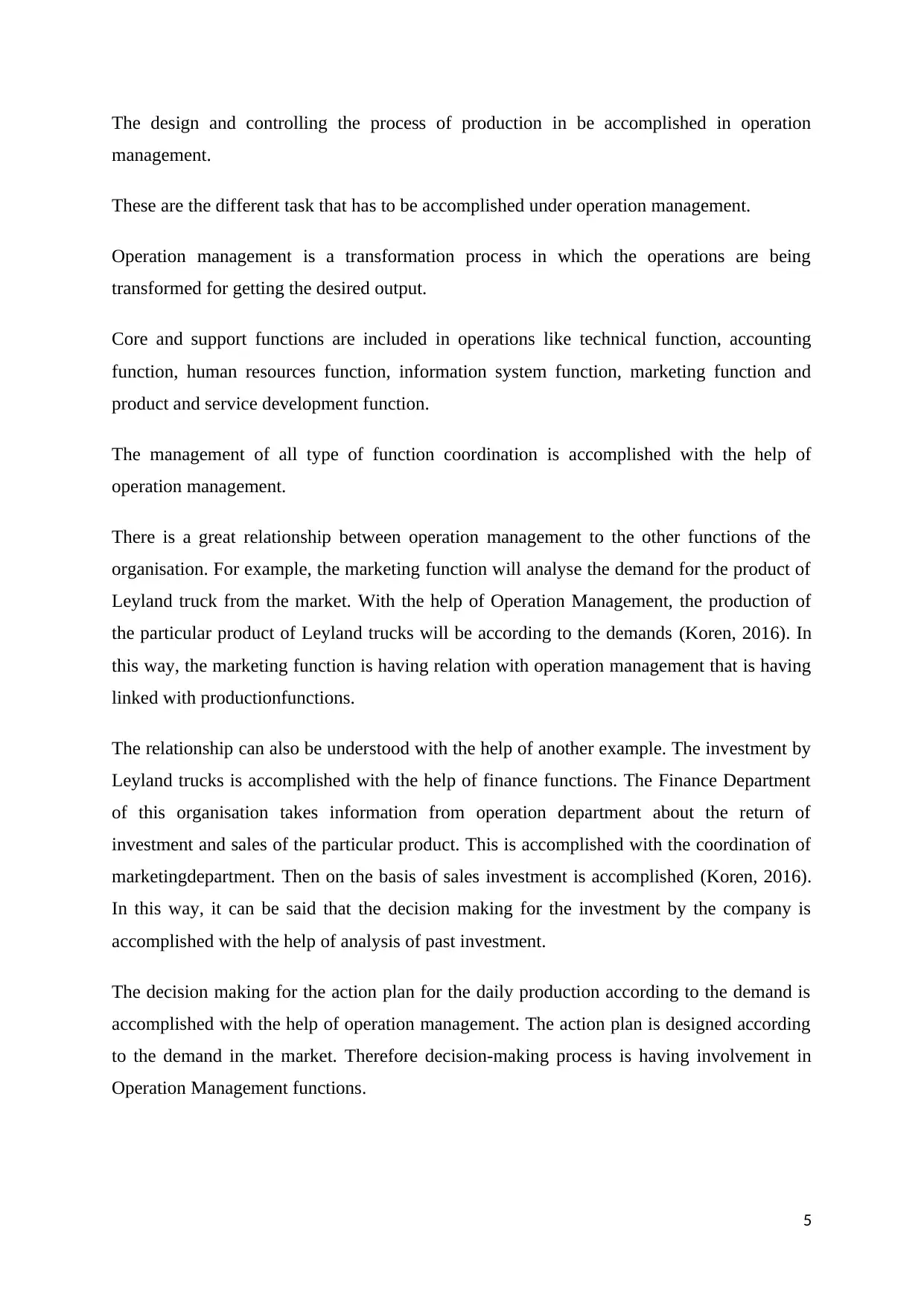
The design and controlling the process of production in be accomplished in operation
management.
These are the different task that has to be accomplished under operation management.
Operation management is a transformation process in which the operations are being
transformed for getting the desired output.
Core and support functions are included in operations like technical function, accounting
function, human resources function, information system function, marketing function and
product and service development function.
The management of all type of function coordination is accomplished with the help of
operation management.
There is a great relationship between operation management to the other functions of the
organisation. For example, the marketing function will analyse the demand for the product of
Leyland truck from the market. With the help of Operation Management, the production of
the particular product of Leyland trucks will be according to the demands (Koren, 2016). In
this way, the marketing function is having relation with operation management that is having
linked with productionfunctions.
The relationship can also be understood with the help of another example. The investment by
Leyland trucks is accomplished with the help of finance functions. The Finance Department
of this organisation takes information from operation department about the return of
investment and sales of the particular product. This is accomplished with the coordination of
marketingdepartment. Then on the basis of sales investment is accomplished (Koren, 2016).
In this way, it can be said that the decision making for the investment by the company is
accomplished with the help of analysis of past investment.
The decision making for the action plan for the daily production according to the demand is
accomplished with the help of operation management. The action plan is designed according
to the demand in the market. Therefore decision-making process is having involvement in
Operation Management functions.
5
management.
These are the different task that has to be accomplished under operation management.
Operation management is a transformation process in which the operations are being
transformed for getting the desired output.
Core and support functions are included in operations like technical function, accounting
function, human resources function, information system function, marketing function and
product and service development function.
The management of all type of function coordination is accomplished with the help of
operation management.
There is a great relationship between operation management to the other functions of the
organisation. For example, the marketing function will analyse the demand for the product of
Leyland truck from the market. With the help of Operation Management, the production of
the particular product of Leyland trucks will be according to the demands (Koren, 2016). In
this way, the marketing function is having relation with operation management that is having
linked with productionfunctions.
The relationship can also be understood with the help of another example. The investment by
Leyland trucks is accomplished with the help of finance functions. The Finance Department
of this organisation takes information from operation department about the return of
investment and sales of the particular product. This is accomplished with the coordination of
marketingdepartment. Then on the basis of sales investment is accomplished (Koren, 2016).
In this way, it can be said that the decision making for the investment by the company is
accomplished with the help of analysis of past investment.
The decision making for the action plan for the daily production according to the demand is
accomplished with the help of operation management. The action plan is designed according
to the demand in the market. Therefore decision-making process is having involvement in
Operation Management functions.
5
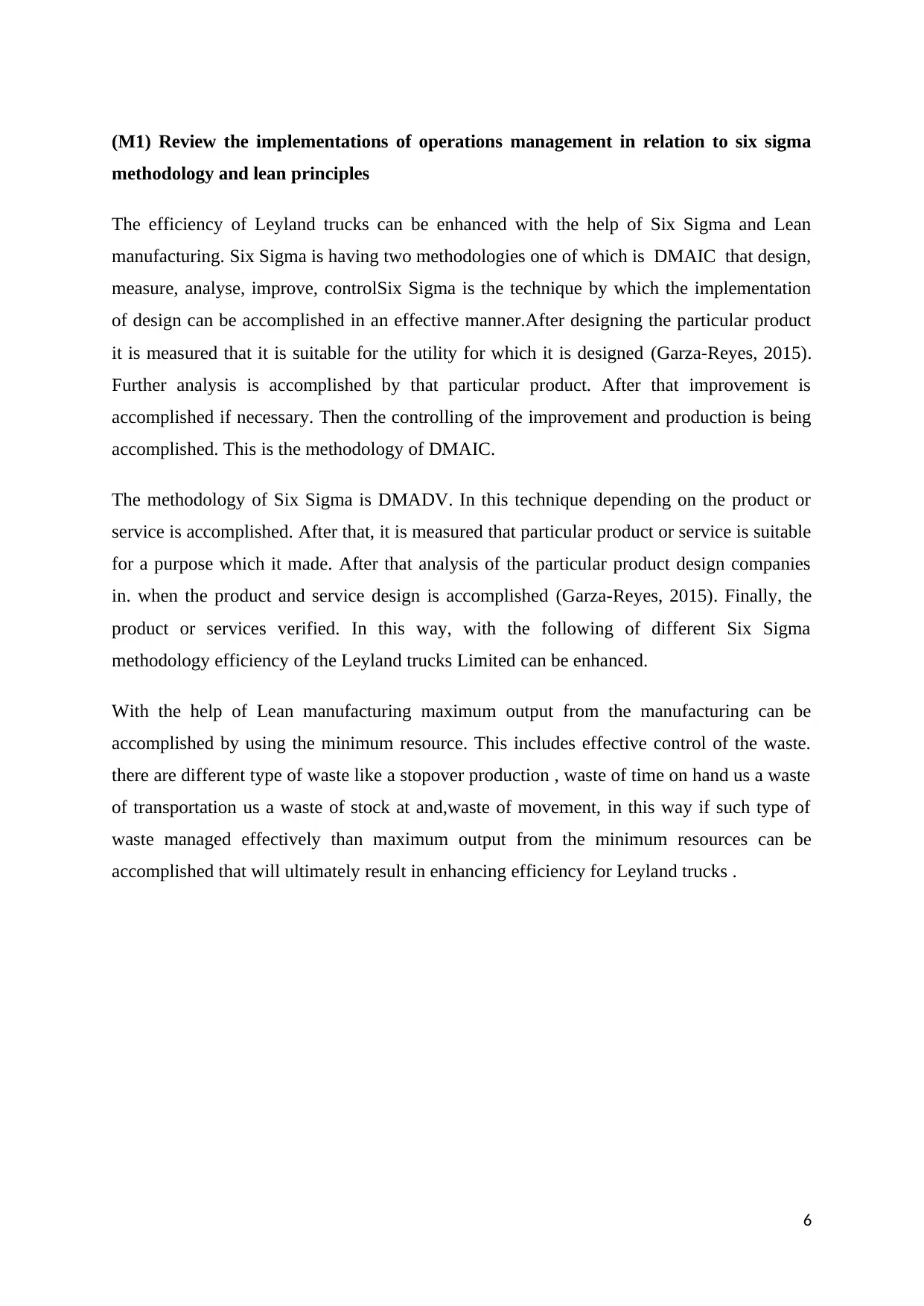
(M1) Review the implementations of operations management in relation to six sigma
methodology and lean principles
The efficiency of Leyland trucks can be enhanced with the help of Six Sigma and Lean
manufacturing. Six Sigma is having two methodologies one of which is DMAIC that design,
measure, analyse, improve, controlSix Sigma is the technique by which the implementation
of design can be accomplished in an effective manner.After designing the particular product
it is measured that it is suitable for the utility for which it is designed (Garza-Reyes, 2015).
Further analysis is accomplished by that particular product. After that improvement is
accomplished if necessary. Then the controlling of the improvement and production is being
accomplished. This is the methodology of DMAIC.
The methodology of Six Sigma is DMADV. In this technique depending on the product or
service is accomplished. After that, it is measured that particular product or service is suitable
for a purpose which it made. After that analysis of the particular product design companies
in. when the product and service design is accomplished (Garza-Reyes, 2015). Finally, the
product or services verified. In this way, with the following of different Six Sigma
methodology efficiency of the Leyland trucks Limited can be enhanced.
With the help of Lean manufacturing maximum output from the manufacturing can be
accomplished by using the minimum resource. This includes effective control of the waste.
there are different type of waste like a stopover production , waste of time on hand us a waste
of transportation us a waste of stock at and,waste of movement, in this way if such type of
waste managed effectively than maximum output from the minimum resources can be
accomplished that will ultimately result in enhancing efficiency for Leyland trucks .
6
methodology and lean principles
The efficiency of Leyland trucks can be enhanced with the help of Six Sigma and Lean
manufacturing. Six Sigma is having two methodologies one of which is DMAIC that design,
measure, analyse, improve, controlSix Sigma is the technique by which the implementation
of design can be accomplished in an effective manner.After designing the particular product
it is measured that it is suitable for the utility for which it is designed (Garza-Reyes, 2015).
Further analysis is accomplished by that particular product. After that improvement is
accomplished if necessary. Then the controlling of the improvement and production is being
accomplished. This is the methodology of DMAIC.
The methodology of Six Sigma is DMADV. In this technique depending on the product or
service is accomplished. After that, it is measured that particular product or service is suitable
for a purpose which it made. After that analysis of the particular product design companies
in. when the product and service design is accomplished (Garza-Reyes, 2015). Finally, the
product or services verified. In this way, with the following of different Six Sigma
methodology efficiency of the Leyland trucks Limited can be enhanced.
With the help of Lean manufacturing maximum output from the manufacturing can be
accomplished by using the minimum resource. This includes effective control of the waste.
there are different type of waste like a stopover production , waste of time on hand us a waste
of transportation us a waste of stock at and,waste of movement, in this way if such type of
waste managed effectively than maximum output from the minimum resources can be
accomplished that will ultimately result in enhancing efficiency for Leyland trucks .
6
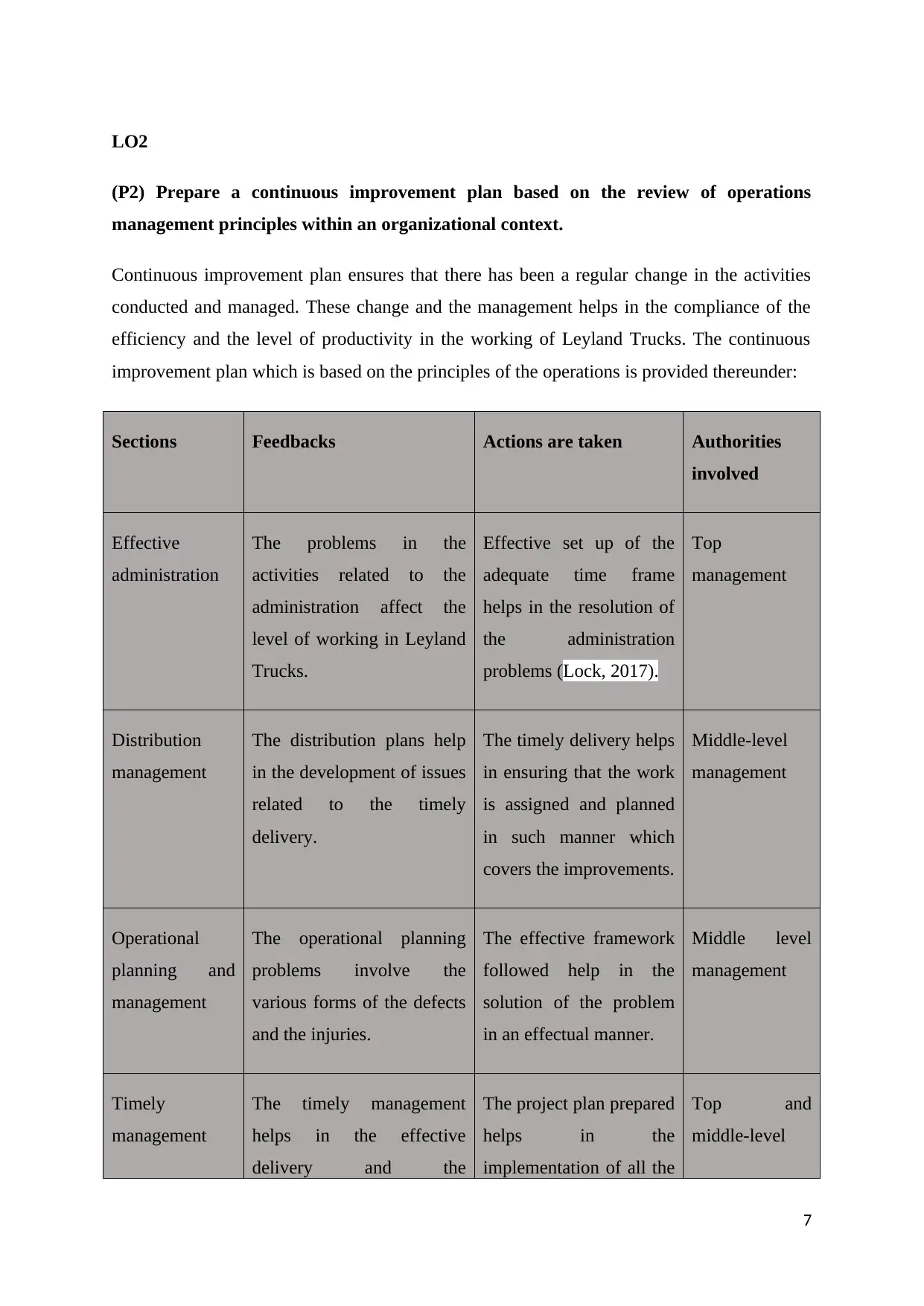
LO2
(P2) Prepare a continuous improvement plan based on the review of operations
management principles within an organizational context.
Continuous improvement plan ensures that there has been a regular change in the activities
conducted and managed. These change and the management helps in the compliance of the
efficiency and the level of productivity in the working of Leyland Trucks. The continuous
improvement plan which is based on the principles of the operations is provided thereunder:
Sections Feedbacks Actions are taken Authorities
involved
Effective
administration
The problems in the
activities related to the
administration affect the
level of working in Leyland
Trucks.
Effective set up of the
adequate time frame
helps in the resolution of
the administration
problems (Lock, 2017).
Top
management
Distribution
management
The distribution plans help
in the development of issues
related to the timely
delivery.
The timely delivery helps
in ensuring that the work
is assigned and planned
in such manner which
covers the improvements.
Middle-level
management
Operational
planning and
management
The operational planning
problems involve the
various forms of the defects
and the injuries.
The effective framework
followed help in the
solution of the problem
in an effectual manner.
Middle level
management
Timely
management
The timely management
helps in the effective
delivery and the
The project plan prepared
helps in the
implementation of all the
Top and
middle-level
7
(P2) Prepare a continuous improvement plan based on the review of operations
management principles within an organizational context.
Continuous improvement plan ensures that there has been a regular change in the activities
conducted and managed. These change and the management helps in the compliance of the
efficiency and the level of productivity in the working of Leyland Trucks. The continuous
improvement plan which is based on the principles of the operations is provided thereunder:
Sections Feedbacks Actions are taken Authorities
involved
Effective
administration
The problems in the
activities related to the
administration affect the
level of working in Leyland
Trucks.
Effective set up of the
adequate time frame
helps in the resolution of
the administration
problems (Lock, 2017).
Top
management
Distribution
management
The distribution plans help
in the development of issues
related to the timely
delivery.
The timely delivery helps
in ensuring that the work
is assigned and planned
in such manner which
covers the improvements.
Middle-level
management
Operational
planning and
management
The operational planning
problems involve the
various forms of the defects
and the injuries.
The effective framework
followed help in the
solution of the problem
in an effectual manner.
Middle level
management
Timely
management
The timely management
helps in the effective
delivery and the
The project plan prepared
helps in the
implementation of all the
Top and
middle-level
7
Secure Best Marks with AI Grader
Need help grading? Try our AI Grader for instant feedback on your assignments.
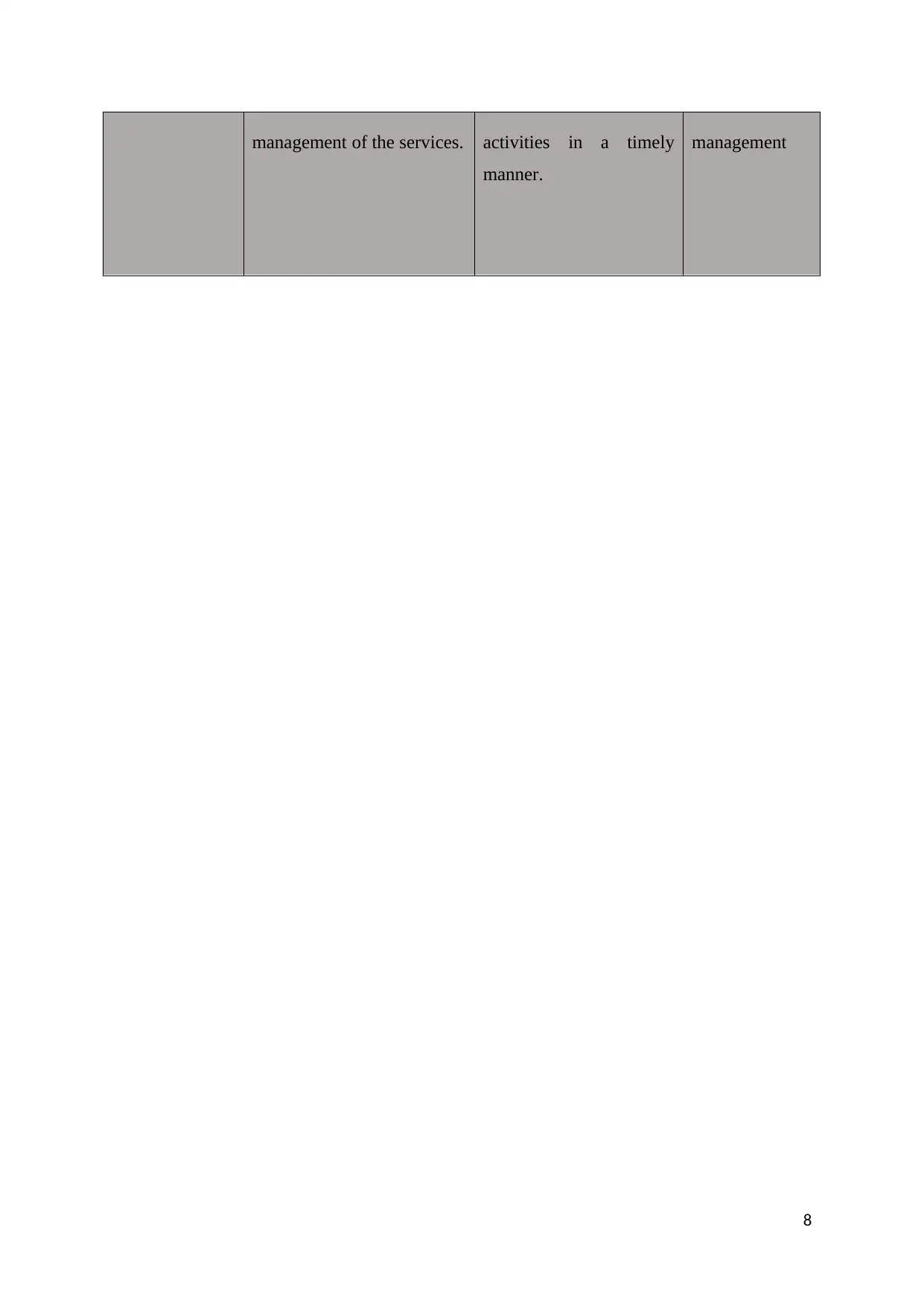
management of the services. activities in a timely
manner.
management
8
manner.
management
8
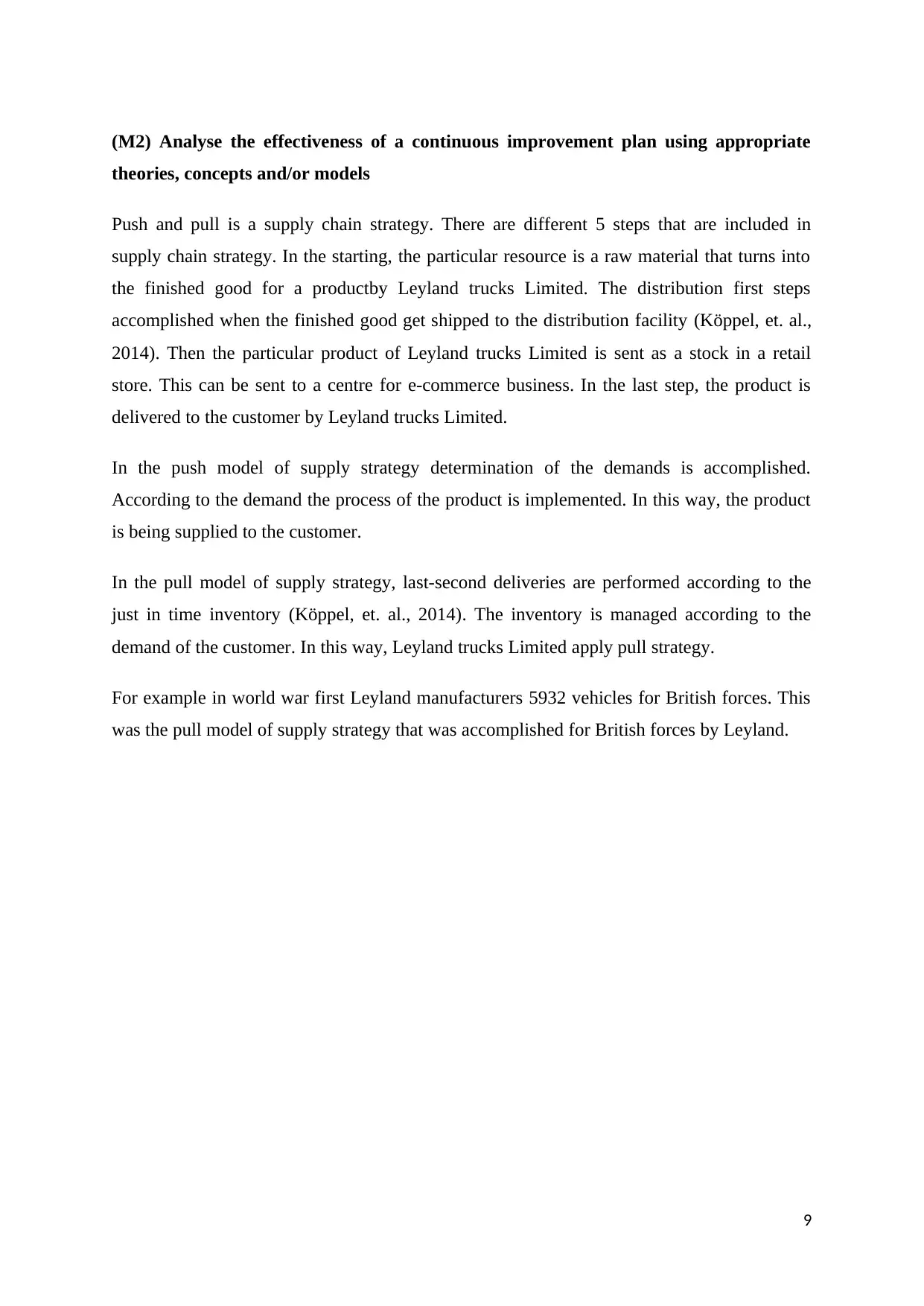
(M2) Analyse the effectiveness of a continuous improvement plan using appropriate
theories, concepts and/or models
Push and pull is a supply chain strategy. There are different 5 steps that are included in
supply chain strategy. In the starting, the particular resource is a raw material that turns into
the finished good for a productby Leyland trucks Limited. The distribution first steps
accomplished when the finished good get shipped to the distribution facility (Köppel, et. al.,
2014). Then the particular product of Leyland trucks Limited is sent as a stock in a retail
store. This can be sent to a centre for e-commerce business. In the last step, the product is
delivered to the customer by Leyland trucks Limited.
In the push model of supply strategy determination of the demands is accomplished.
According to the demand the process of the product is implemented. In this way, the product
is being supplied to the customer.
In the pull model of supply strategy, last-second deliveries are performed according to the
just in time inventory (Köppel, et. al., 2014). The inventory is managed according to the
demand of the customer. In this way, Leyland trucks Limited apply pull strategy.
For example in world war first Leyland manufacturers 5932 vehicles for British forces. This
was the pull model of supply strategy that was accomplished for British forces by Leyland.
9
theories, concepts and/or models
Push and pull is a supply chain strategy. There are different 5 steps that are included in
supply chain strategy. In the starting, the particular resource is a raw material that turns into
the finished good for a productby Leyland trucks Limited. The distribution first steps
accomplished when the finished good get shipped to the distribution facility (Köppel, et. al.,
2014). Then the particular product of Leyland trucks Limited is sent as a stock in a retail
store. This can be sent to a centre for e-commerce business. In the last step, the product is
delivered to the customer by Leyland trucks Limited.
In the push model of supply strategy determination of the demands is accomplished.
According to the demand the process of the product is implemented. In this way, the product
is being supplied to the customer.
In the pull model of supply strategy, last-second deliveries are performed according to the
just in time inventory (Köppel, et. al., 2014). The inventory is managed according to the
demand of the customer. In this way, Leyland trucks Limited apply pull strategy.
For example in world war first Leyland manufacturers 5932 vehicles for British forces. This
was the pull model of supply strategy that was accomplished for British forces by Leyland.
9
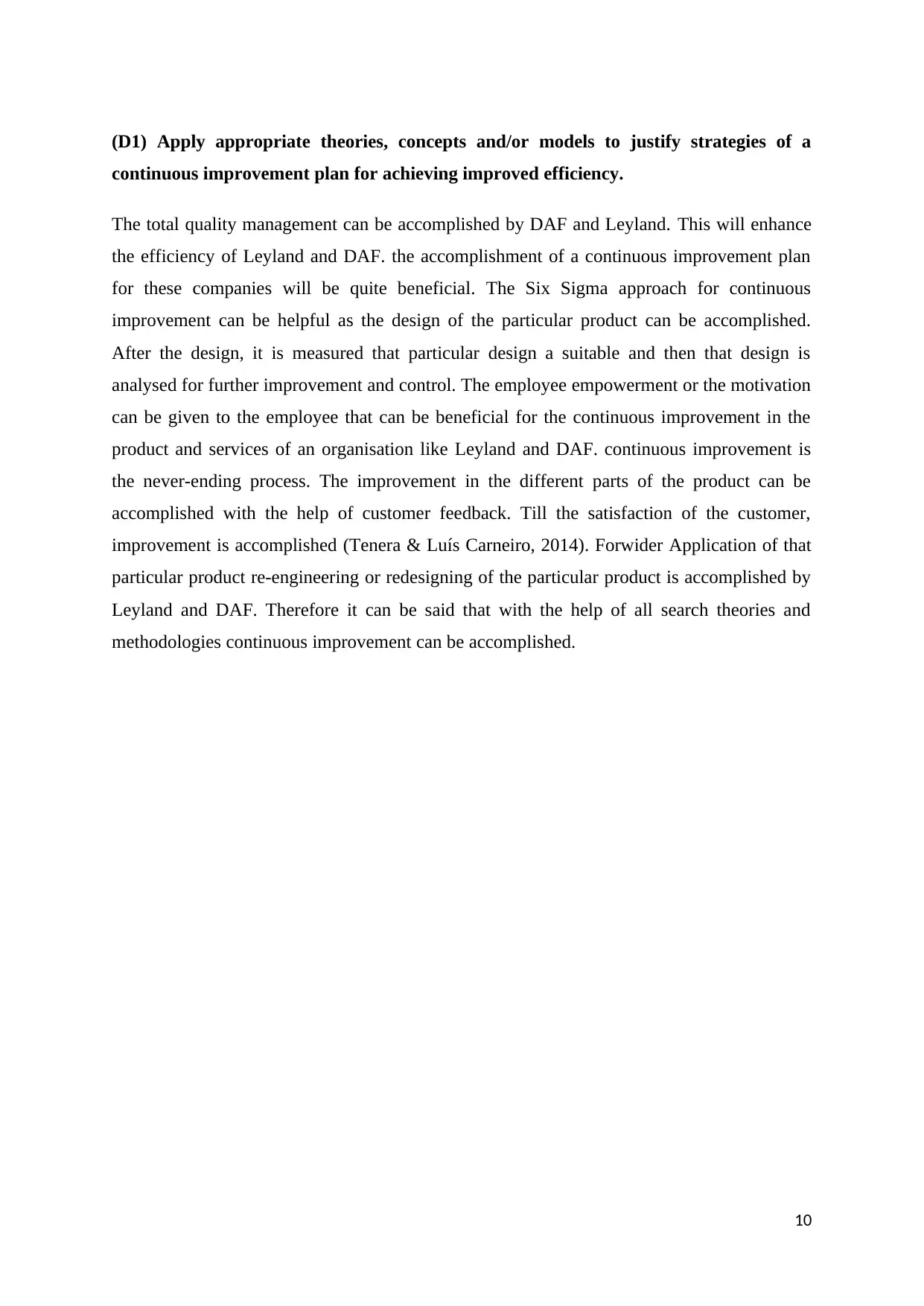
(D1) Apply appropriate theories, concepts and/or models to justify strategies of a
continuous improvement plan for achieving improved efficiency.
The total quality management can be accomplished by DAF and Leyland. This will enhance
the efficiency of Leyland and DAF. the accomplishment of a continuous improvement plan
for these companies will be quite beneficial. The Six Sigma approach for continuous
improvement can be helpful as the design of the particular product can be accomplished.
After the design, it is measured that particular design a suitable and then that design is
analysed for further improvement and control. The employee empowerment or the motivation
can be given to the employee that can be beneficial for the continuous improvement in the
product and services of an organisation like Leyland and DAF. continuous improvement is
the never-ending process. The improvement in the different parts of the product can be
accomplished with the help of customer feedback. Till the satisfaction of the customer,
improvement is accomplished (Tenera & Luís Carneiro, 2014). Forwider Application of that
particular product re-engineering or redesigning of the particular product is accomplished by
Leyland and DAF. Therefore it can be said that with the help of all search theories and
methodologies continuous improvement can be accomplished.
10
continuous improvement plan for achieving improved efficiency.
The total quality management can be accomplished by DAF and Leyland. This will enhance
the efficiency of Leyland and DAF. the accomplishment of a continuous improvement plan
for these companies will be quite beneficial. The Six Sigma approach for continuous
improvement can be helpful as the design of the particular product can be accomplished.
After the design, it is measured that particular design a suitable and then that design is
analysed for further improvement and control. The employee empowerment or the motivation
can be given to the employee that can be beneficial for the continuous improvement in the
product and services of an organisation like Leyland and DAF. continuous improvement is
the never-ending process. The improvement in the different parts of the product can be
accomplished with the help of customer feedback. Till the satisfaction of the customer,
improvement is accomplished (Tenera & Luís Carneiro, 2014). Forwider Application of that
particular product re-engineering or redesigning of the particular product is accomplished by
Leyland and DAF. Therefore it can be said that with the help of all search theories and
methodologies continuous improvement can be accomplished.
10
Paraphrase This Document
Need a fresh take? Get an instant paraphrase of this document with our AI Paraphraser
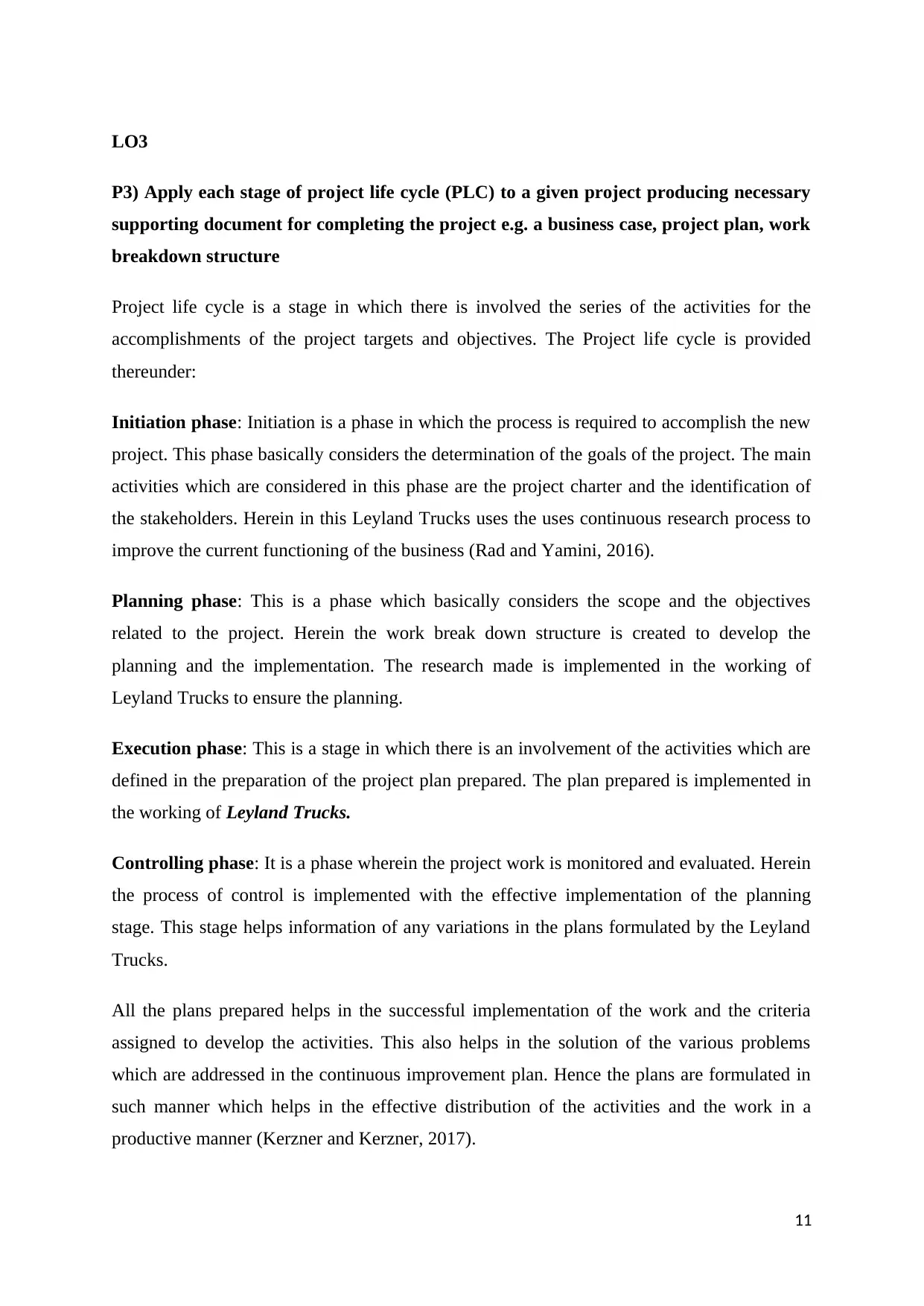
LO3
P3) Apply each stage of project life cycle (PLC) to a given project producing necessary
supporting document for completing the project e.g. a business case, project plan, work
breakdown structure
Project life cycle is a stage in which there is involved the series of the activities for the
accomplishments of the project targets and objectives. The Project life cycle is provided
thereunder:
Initiation phase: Initiation is a phase in which the process is required to accomplish the new
project. This phase basically considers the determination of the goals of the project. The main
activities which are considered in this phase are the project charter and the identification of
the stakeholders. Herein in this Leyland Trucks uses the uses continuous research process to
improve the current functioning of the business (Rad and Yamini, 2016).
Planning phase: This is a phase which basically considers the scope and the objectives
related to the project. Herein the work break down structure is created to develop the
planning and the implementation. The research made is implemented in the working of
Leyland Trucks to ensure the planning.
Execution phase: This is a stage in which there is an involvement of the activities which are
defined in the preparation of the project plan prepared. The plan prepared is implemented in
the working of Leyland Trucks.
Controlling phase: It is a phase wherein the project work is monitored and evaluated. Herein
the process of control is implemented with the effective implementation of the planning
stage. This stage helps information of any variations in the plans formulated by the Leyland
Trucks.
All the plans prepared helps in the successful implementation of the work and the criteria
assigned to develop the activities. This also helps in the solution of the various problems
which are addressed in the continuous improvement plan. Hence the plans are formulated in
such manner which helps in the effective distribution of the activities and the work in a
productive manner (Kerzner and Kerzner, 2017).
11
P3) Apply each stage of project life cycle (PLC) to a given project producing necessary
supporting document for completing the project e.g. a business case, project plan, work
breakdown structure
Project life cycle is a stage in which there is involved the series of the activities for the
accomplishments of the project targets and objectives. The Project life cycle is provided
thereunder:
Initiation phase: Initiation is a phase in which the process is required to accomplish the new
project. This phase basically considers the determination of the goals of the project. The main
activities which are considered in this phase are the project charter and the identification of
the stakeholders. Herein in this Leyland Trucks uses the uses continuous research process to
improve the current functioning of the business (Rad and Yamini, 2016).
Planning phase: This is a phase which basically considers the scope and the objectives
related to the project. Herein the work break down structure is created to develop the
planning and the implementation. The research made is implemented in the working of
Leyland Trucks to ensure the planning.
Execution phase: This is a stage in which there is an involvement of the activities which are
defined in the preparation of the project plan prepared. The plan prepared is implemented in
the working of Leyland Trucks.
Controlling phase: It is a phase wherein the project work is monitored and evaluated. Herein
the process of control is implemented with the effective implementation of the planning
stage. This stage helps information of any variations in the plans formulated by the Leyland
Trucks.
All the plans prepared helps in the successful implementation of the work and the criteria
assigned to develop the activities. This also helps in the solution of the various problems
which are addressed in the continuous improvement plan. Hence the plans are formulated in
such manner which helps in the effective distribution of the activities and the work in a
productive manner (Kerzner and Kerzner, 2017).
11
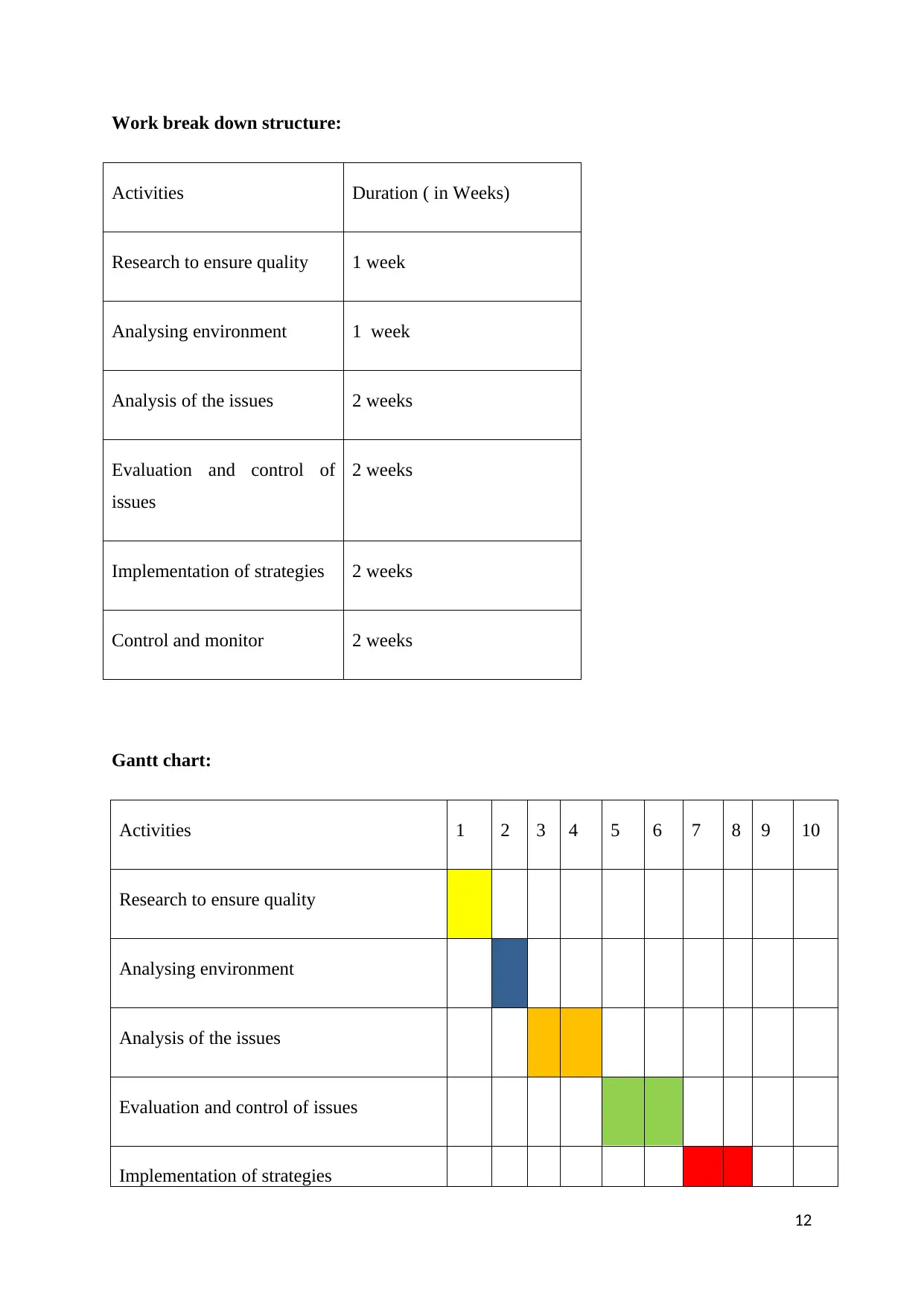
Work break down structure:
Activities Duration ( in Weeks)
Research to ensure quality 1 week
Analysing environment 1 week
Analysis of the issues 2 weeks
Evaluation and control of
issues
2 weeks
Implementation of strategies 2 weeks
Control and monitor 2 weeks
Gantt chart:
Activities 1 2 3 4 5 6 7 8 9 10
Research to ensure quality
Analysing environment
Analysis of the issues
Evaluation and control of issues
Implementation of strategies
12
Activities Duration ( in Weeks)
Research to ensure quality 1 week
Analysing environment 1 week
Analysis of the issues 2 weeks
Evaluation and control of
issues
2 weeks
Implementation of strategies 2 weeks
Control and monitor 2 weeks
Gantt chart:
Activities 1 2 3 4 5 6 7 8 9 10
Research to ensure quality
Analysing environment
Analysis of the issues
Evaluation and control of issues
Implementation of strategies
12

Control and monitor
13
13
Secure Best Marks with AI Grader
Need help grading? Try our AI Grader for instant feedback on your assignments.
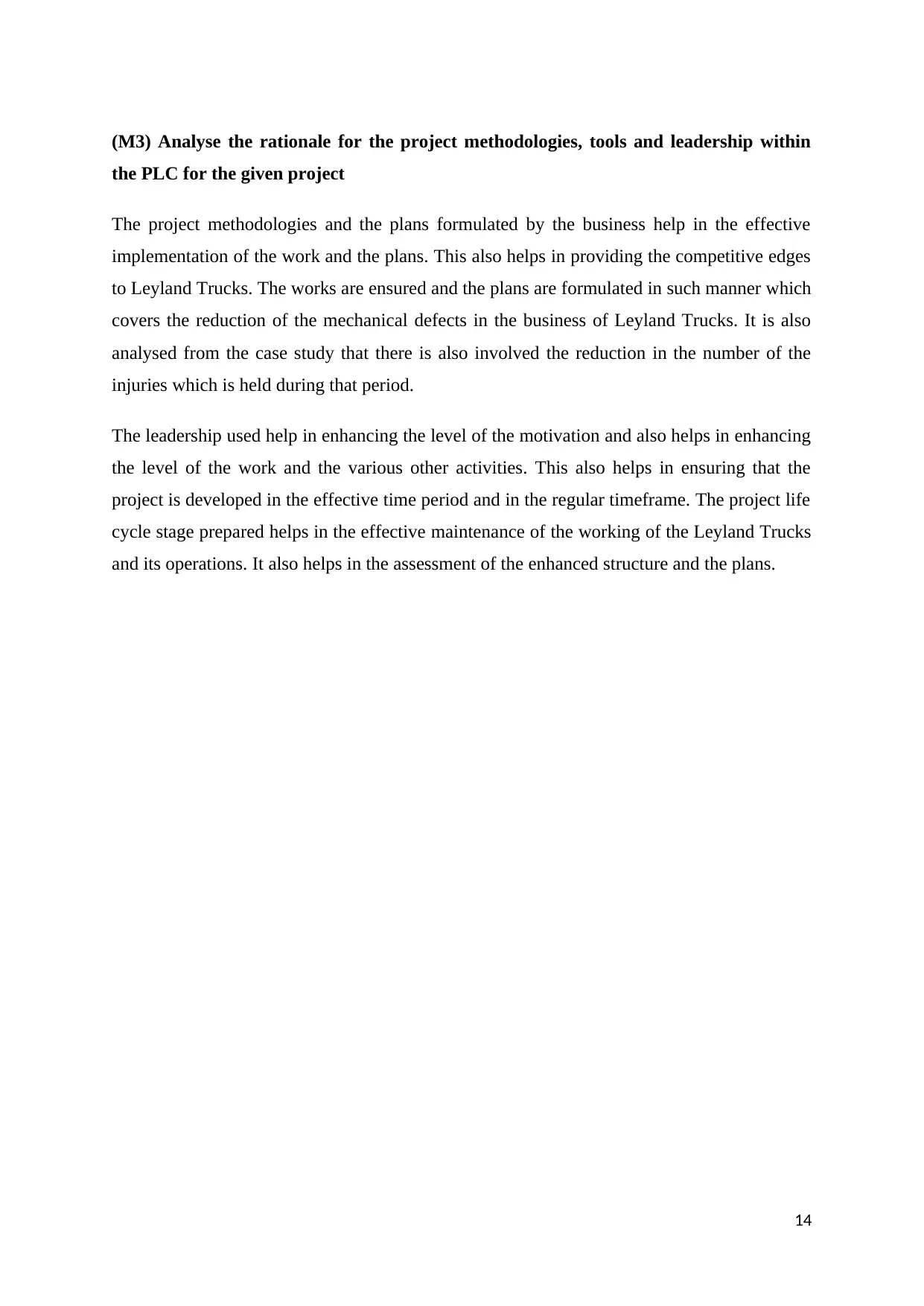
(M3) Analyse the rationale for the project methodologies, tools and leadership within
the PLC for the given project
The project methodologies and the plans formulated by the business help in the effective
implementation of the work and the plans. This also helps in providing the competitive edges
to Leyland Trucks. The works are ensured and the plans are formulated in such manner which
covers the reduction of the mechanical defects in the business of Leyland Trucks. It is also
analysed from the case study that there is also involved the reduction in the number of the
injuries which is held during that period.
The leadership used help in enhancing the level of the motivation and also helps in enhancing
the level of the work and the various other activities. This also helps in ensuring that the
project is developed in the effective time period and in the regular timeframe. The project life
cycle stage prepared helps in the effective maintenance of the working of the Leyland Trucks
and its operations. It also helps in the assessment of the enhanced structure and the plans.
14
the PLC for the given project
The project methodologies and the plans formulated by the business help in the effective
implementation of the work and the plans. This also helps in providing the competitive edges
to Leyland Trucks. The works are ensured and the plans are formulated in such manner which
covers the reduction of the mechanical defects in the business of Leyland Trucks. It is also
analysed from the case study that there is also involved the reduction in the number of the
injuries which is held during that period.
The leadership used help in enhancing the level of the motivation and also helps in enhancing
the level of the work and the various other activities. This also helps in ensuring that the
project is developed in the effective time period and in the regular timeframe. The project life
cycle stage prepared helps in the effective maintenance of the working of the Leyland Trucks
and its operations. It also helps in the assessment of the enhanced structure and the plans.
14
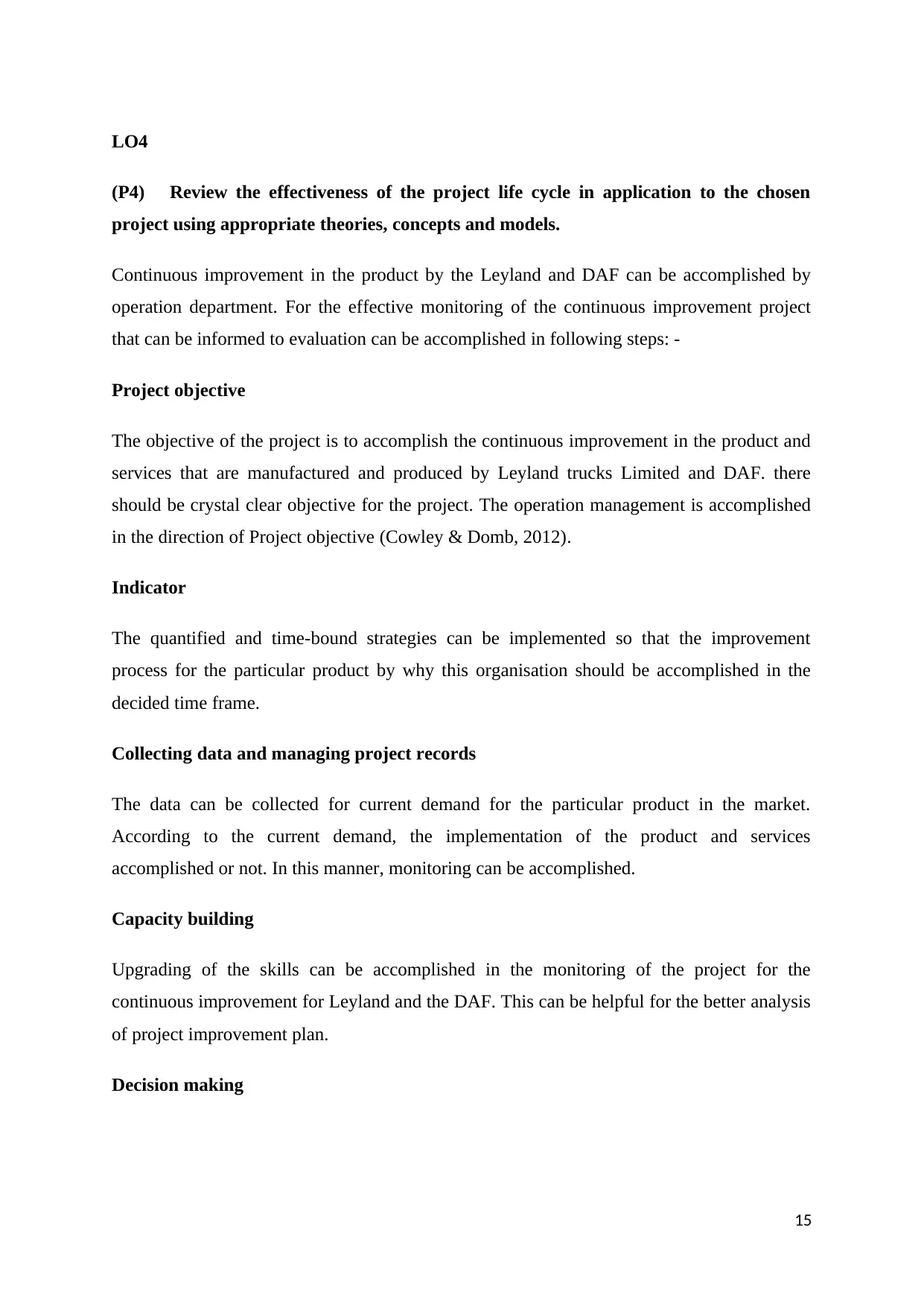
LO4
(P4) Review the effectiveness of the project life cycle in application to the chosen
project using appropriate theories, concepts and models.
Continuous improvement in the product by the Leyland and DAF can be accomplished by
operation department. For the effective monitoring of the continuous improvement project
that can be informed to evaluation can be accomplished in following steps: -
Project objective
The objective of the project is to accomplish the continuous improvement in the product and
services that are manufactured and produced by Leyland trucks Limited and DAF. there
should be crystal clear objective for the project. The operation management is accomplished
in the direction of Project objective (Cowley & Domb, 2012).
Indicator
The quantified and time-bound strategies can be implemented so that the improvement
process for the particular product by why this organisation should be accomplished in the
decided time frame.
Collecting data and managing project records
The data can be collected for current demand for the particular product in the market.
According to the current demand, the implementation of the product and services
accomplished or not. In this manner, monitoring can be accomplished.
Capacity building
Upgrading of the skills can be accomplished in the monitoring of the project for the
continuous improvement for Leyland and the DAF. This can be helpful for the better analysis
of project improvement plan.
Decision making
15
(P4) Review the effectiveness of the project life cycle in application to the chosen
project using appropriate theories, concepts and models.
Continuous improvement in the product by the Leyland and DAF can be accomplished by
operation department. For the effective monitoring of the continuous improvement project
that can be informed to evaluation can be accomplished in following steps: -
Project objective
The objective of the project is to accomplish the continuous improvement in the product and
services that are manufactured and produced by Leyland trucks Limited and DAF. there
should be crystal clear objective for the project. The operation management is accomplished
in the direction of Project objective (Cowley & Domb, 2012).
Indicator
The quantified and time-bound strategies can be implemented so that the improvement
process for the particular product by why this organisation should be accomplished in the
decided time frame.
Collecting data and managing project records
The data can be collected for current demand for the particular product in the market.
According to the current demand, the implementation of the product and services
accomplished or not. In this manner, monitoring can be accomplished.
Capacity building
Upgrading of the skills can be accomplished in the monitoring of the project for the
continuous improvement for Leyland and the DAF. This can be helpful for the better analysis
of project improvement plan.
Decision making
15
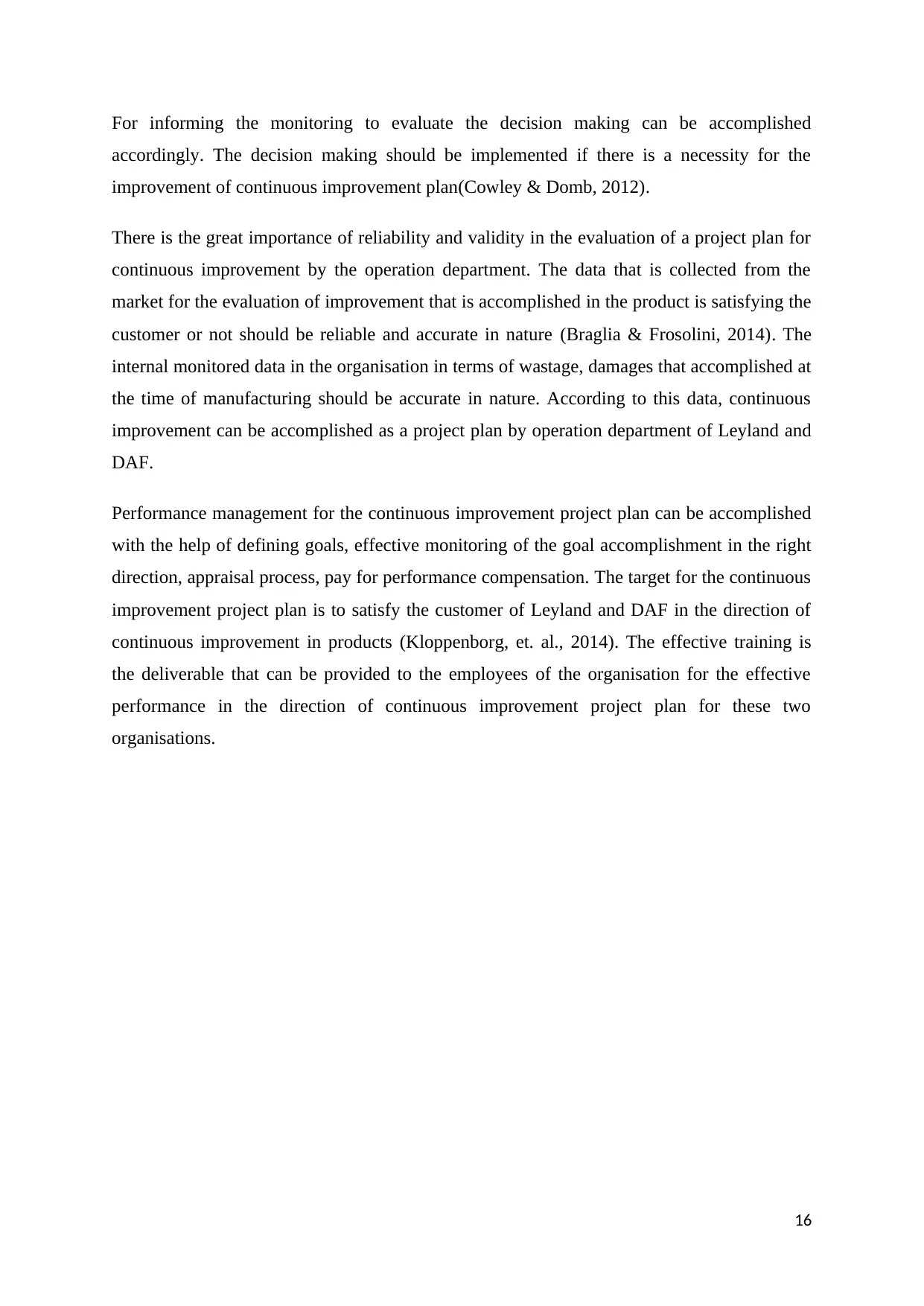
For informing the monitoring to evaluate the decision making can be accomplished
accordingly. The decision making should be implemented if there is a necessity for the
improvement of continuous improvement plan(Cowley & Domb, 2012).
There is the great importance of reliability and validity in the evaluation of a project plan for
continuous improvement by the operation department. The data that is collected from the
market for the evaluation of improvement that is accomplished in the product is satisfying the
customer or not should be reliable and accurate in nature (Braglia & Frosolini, 2014). The
internal monitored data in the organisation in terms of wastage, damages that accomplished at
the time of manufacturing should be accurate in nature. According to this data, continuous
improvement can be accomplished as a project plan by operation department of Leyland and
DAF.
Performance management for the continuous improvement project plan can be accomplished
with the help of defining goals, effective monitoring of the goal accomplishment in the right
direction, appraisal process, pay for performance compensation. The target for the continuous
improvement project plan is to satisfy the customer of Leyland and DAF in the direction of
continuous improvement in products (Kloppenborg, et. al., 2014). The effective training is
the deliverable that can be provided to the employees of the organisation for the effective
performance in the direction of continuous improvement project plan for these two
organisations.
16
accordingly. The decision making should be implemented if there is a necessity for the
improvement of continuous improvement plan(Cowley & Domb, 2012).
There is the great importance of reliability and validity in the evaluation of a project plan for
continuous improvement by the operation department. The data that is collected from the
market for the evaluation of improvement that is accomplished in the product is satisfying the
customer or not should be reliable and accurate in nature (Braglia & Frosolini, 2014). The
internal monitored data in the organisation in terms of wastage, damages that accomplished at
the time of manufacturing should be accurate in nature. According to this data, continuous
improvement can be accomplished as a project plan by operation department of Leyland and
DAF.
Performance management for the continuous improvement project plan can be accomplished
with the help of defining goals, effective monitoring of the goal accomplishment in the right
direction, appraisal process, pay for performance compensation. The target for the continuous
improvement project plan is to satisfy the customer of Leyland and DAF in the direction of
continuous improvement in products (Kloppenborg, et. al., 2014). The effective training is
the deliverable that can be provided to the employees of the organisation for the effective
performance in the direction of continuous improvement project plan for these two
organisations.
16
Paraphrase This Document
Need a fresh take? Get an instant paraphrase of this document with our AI Paraphraser
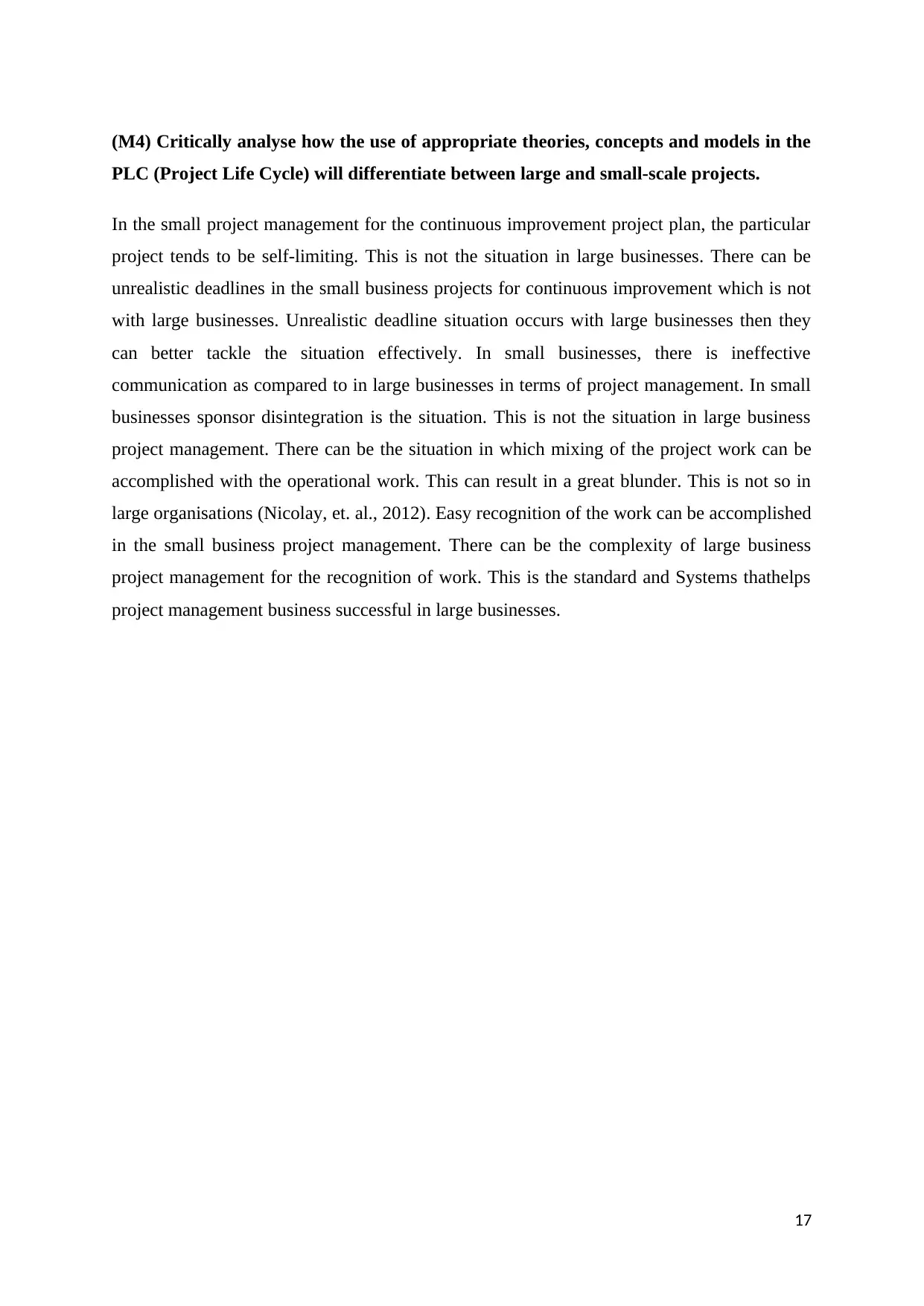
(M4) Critically analyse how the use of appropriate theories, concepts and models in the
PLC (Project Life Cycle) will differentiate between large and small-scale projects.
In the small project management for the continuous improvement project plan, the particular
project tends to be self-limiting. This is not the situation in large businesses. There can be
unrealistic deadlines in the small business projects for continuous improvement which is not
with large businesses. Unrealistic deadline situation occurs with large businesses then they
can better tackle the situation effectively. In small businesses, there is ineffective
communication as compared to in large businesses in terms of project management. In small
businesses sponsor disintegration is the situation. This is not the situation in large business
project management. There can be the situation in which mixing of the project work can be
accomplished with the operational work. This can result in a great blunder. This is not so in
large organisations (Nicolay, et. al., 2012). Easy recognition of the work can be accomplished
in the small business project management. There can be the complexity of large business
project management for the recognition of work. This is the standard and Systems thathelps
project management business successful in large businesses.
17
PLC (Project Life Cycle) will differentiate between large and small-scale projects.
In the small project management for the continuous improvement project plan, the particular
project tends to be self-limiting. This is not the situation in large businesses. There can be
unrealistic deadlines in the small business projects for continuous improvement which is not
with large businesses. Unrealistic deadline situation occurs with large businesses then they
can better tackle the situation effectively. In small businesses, there is ineffective
communication as compared to in large businesses in terms of project management. In small
businesses sponsor disintegration is the situation. This is not the situation in large business
project management. There can be the situation in which mixing of the project work can be
accomplished with the operational work. This can result in a great blunder. This is not so in
large organisations (Nicolay, et. al., 2012). Easy recognition of the work can be accomplished
in the small business project management. There can be the complexity of large business
project management for the recognition of work. This is the standard and Systems thathelps
project management business successful in large businesses.
17

(D2) Critically evaluate the PLC through a practical and theoretical exploration of its
effectiveness.
Initiation phase is very important in accomplishing the project plan for the continuous
improvement for Leyland. It is the base for the project life cycle. All the objectives of the
project life cycle are being decided at this phase. The planning phase is also helpful in the
implementation of objective strategy in a descriptive manner. After that execution can be
accomplished by all the strategies in an efficient manner (Li, et. al., 2012). Then the
particular project is controlled with the regular research and development and the customer
feedback for the product of Leyland and D A F. the situation in which the failure of the
execution phase can be accomplished because of ineffective planning phase implementation.
Therefore it is very necessary to plan the strategies indirection of continuousimprovement.
18
effectiveness.
Initiation phase is very important in accomplishing the project plan for the continuous
improvement for Leyland. It is the base for the project life cycle. All the objectives of the
project life cycle are being decided at this phase. The planning phase is also helpful in the
implementation of objective strategy in a descriptive manner. After that execution can be
accomplished by all the strategies in an efficient manner (Li, et. al., 2012). Then the
particular project is controlled with the regular research and development and the customer
feedback for the product of Leyland and D A F. the situation in which the failure of the
execution phase can be accomplished because of ineffective planning phase implementation.
Therefore it is very necessary to plan the strategies indirection of continuousimprovement.
18
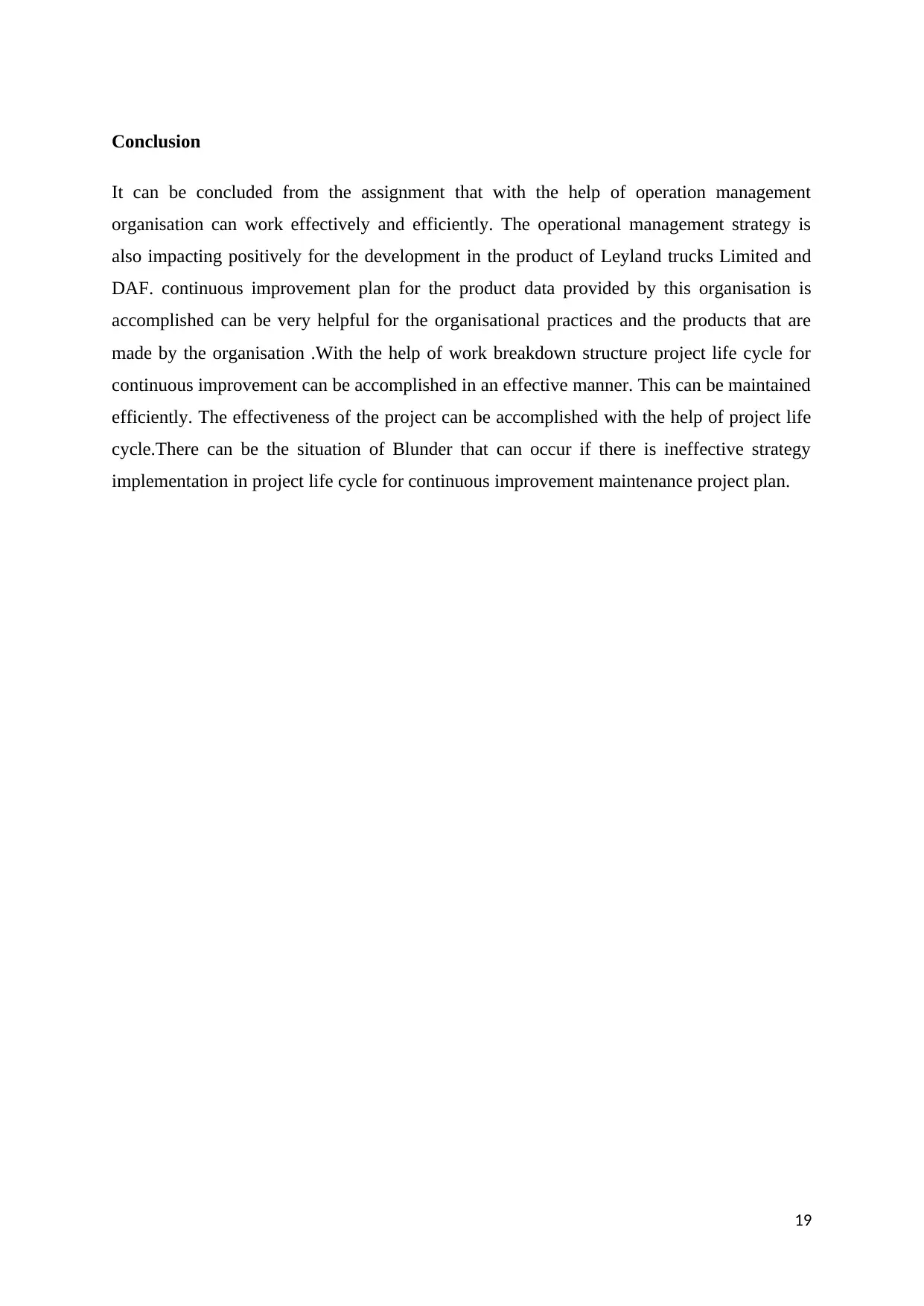
Conclusion
It can be concluded from the assignment that with the help of operation management
organisation can work effectively and efficiently. The operational management strategy is
also impacting positively for the development in the product of Leyland trucks Limited and
DAF. continuous improvement plan for the product data provided by this organisation is
accomplished can be very helpful for the organisational practices and the products that are
made by the organisation .With the help of work breakdown structure project life cycle for
continuous improvement can be accomplished in an effective manner. This can be maintained
efficiently. The effectiveness of the project can be accomplished with the help of project life
cycle.There can be the situation of Blunder that can occur if there is ineffective strategy
implementation in project life cycle for continuous improvement maintenance project plan.
19
It can be concluded from the assignment that with the help of operation management
organisation can work effectively and efficiently. The operational management strategy is
also impacting positively for the development in the product of Leyland trucks Limited and
DAF. continuous improvement plan for the product data provided by this organisation is
accomplished can be very helpful for the organisational practices and the products that are
made by the organisation .With the help of work breakdown structure project life cycle for
continuous improvement can be accomplished in an effective manner. This can be maintained
efficiently. The effectiveness of the project can be accomplished with the help of project life
cycle.There can be the situation of Blunder that can occur if there is ineffective strategy
implementation in project life cycle for continuous improvement maintenance project plan.
19
Secure Best Marks with AI Grader
Need help grading? Try our AI Grader for instant feedback on your assignments.
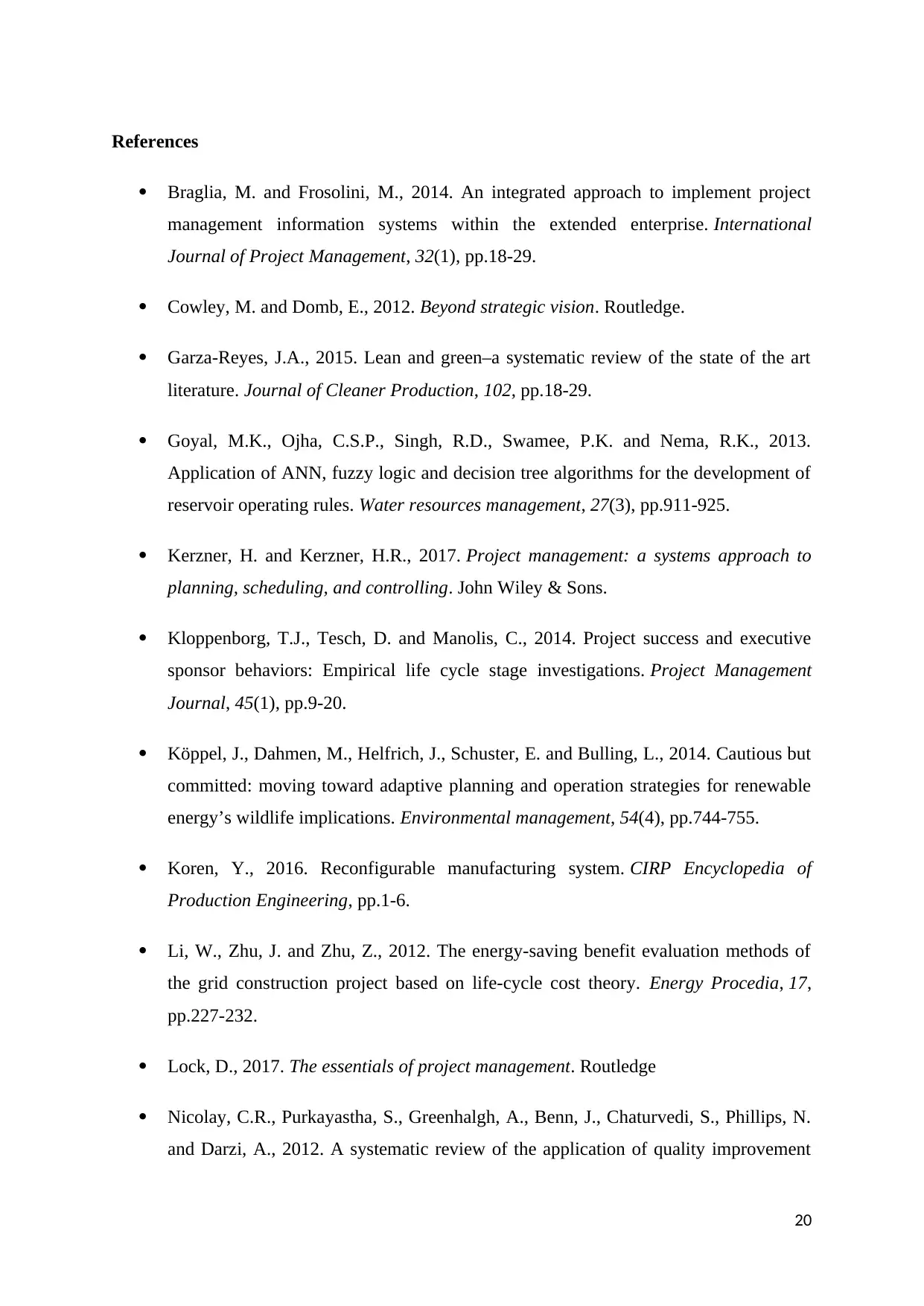
References
Braglia, M. and Frosolini, M., 2014. An integrated approach to implement project
management information systems within the extended enterprise. International
Journal of Project Management, 32(1), pp.18-29.
Cowley, M. and Domb, E., 2012. Beyond strategic vision. Routledge.
Garza-Reyes, J.A., 2015. Lean and green–a systematic review of the state of the art
literature. Journal of Cleaner Production, 102, pp.18-29.
Goyal, M.K., Ojha, C.S.P., Singh, R.D., Swamee, P.K. and Nema, R.K., 2013.
Application of ANN, fuzzy logic and decision tree algorithms for the development of
reservoir operating rules. Water resources management, 27(3), pp.911-925.
Kerzner, H. and Kerzner, H.R., 2017. Project management: a systems approach to
planning, scheduling, and controlling. John Wiley & Sons.
Kloppenborg, T.J., Tesch, D. and Manolis, C., 2014. Project success and executive
sponsor behaviors: Empirical life cycle stage investigations. Project Management
Journal, 45(1), pp.9-20.
Köppel, J., Dahmen, M., Helfrich, J., Schuster, E. and Bulling, L., 2014. Cautious but
committed: moving toward adaptive planning and operation strategies for renewable
energy’s wildlife implications. Environmental management, 54(4), pp.744-755.
Koren, Y., 2016. Reconfigurable manufacturing system. CIRP Encyclopedia of
Production Engineering, pp.1-6.
Li, W., Zhu, J. and Zhu, Z., 2012. The energy-saving benefit evaluation methods of
the grid construction project based on life-cycle cost theory. Energy Procedia, 17,
pp.227-232.
Lock, D., 2017. The essentials of project management. Routledge
Nicolay, C.R., Purkayastha, S., Greenhalgh, A., Benn, J., Chaturvedi, S., Phillips, N.
and Darzi, A., 2012. A systematic review of the application of quality improvement
20
Braglia, M. and Frosolini, M., 2014. An integrated approach to implement project
management information systems within the extended enterprise. International
Journal of Project Management, 32(1), pp.18-29.
Cowley, M. and Domb, E., 2012. Beyond strategic vision. Routledge.
Garza-Reyes, J.A., 2015. Lean and green–a systematic review of the state of the art
literature. Journal of Cleaner Production, 102, pp.18-29.
Goyal, M.K., Ojha, C.S.P., Singh, R.D., Swamee, P.K. and Nema, R.K., 2013.
Application of ANN, fuzzy logic and decision tree algorithms for the development of
reservoir operating rules. Water resources management, 27(3), pp.911-925.
Kerzner, H. and Kerzner, H.R., 2017. Project management: a systems approach to
planning, scheduling, and controlling. John Wiley & Sons.
Kloppenborg, T.J., Tesch, D. and Manolis, C., 2014. Project success and executive
sponsor behaviors: Empirical life cycle stage investigations. Project Management
Journal, 45(1), pp.9-20.
Köppel, J., Dahmen, M., Helfrich, J., Schuster, E. and Bulling, L., 2014. Cautious but
committed: moving toward adaptive planning and operation strategies for renewable
energy’s wildlife implications. Environmental management, 54(4), pp.744-755.
Koren, Y., 2016. Reconfigurable manufacturing system. CIRP Encyclopedia of
Production Engineering, pp.1-6.
Li, W., Zhu, J. and Zhu, Z., 2012. The energy-saving benefit evaluation methods of
the grid construction project based on life-cycle cost theory. Energy Procedia, 17,
pp.227-232.
Lock, D., 2017. The essentials of project management. Routledge
Nicolay, C.R., Purkayastha, S., Greenhalgh, A., Benn, J., Chaturvedi, S., Phillips, N.
and Darzi, A., 2012. A systematic review of the application of quality improvement
20
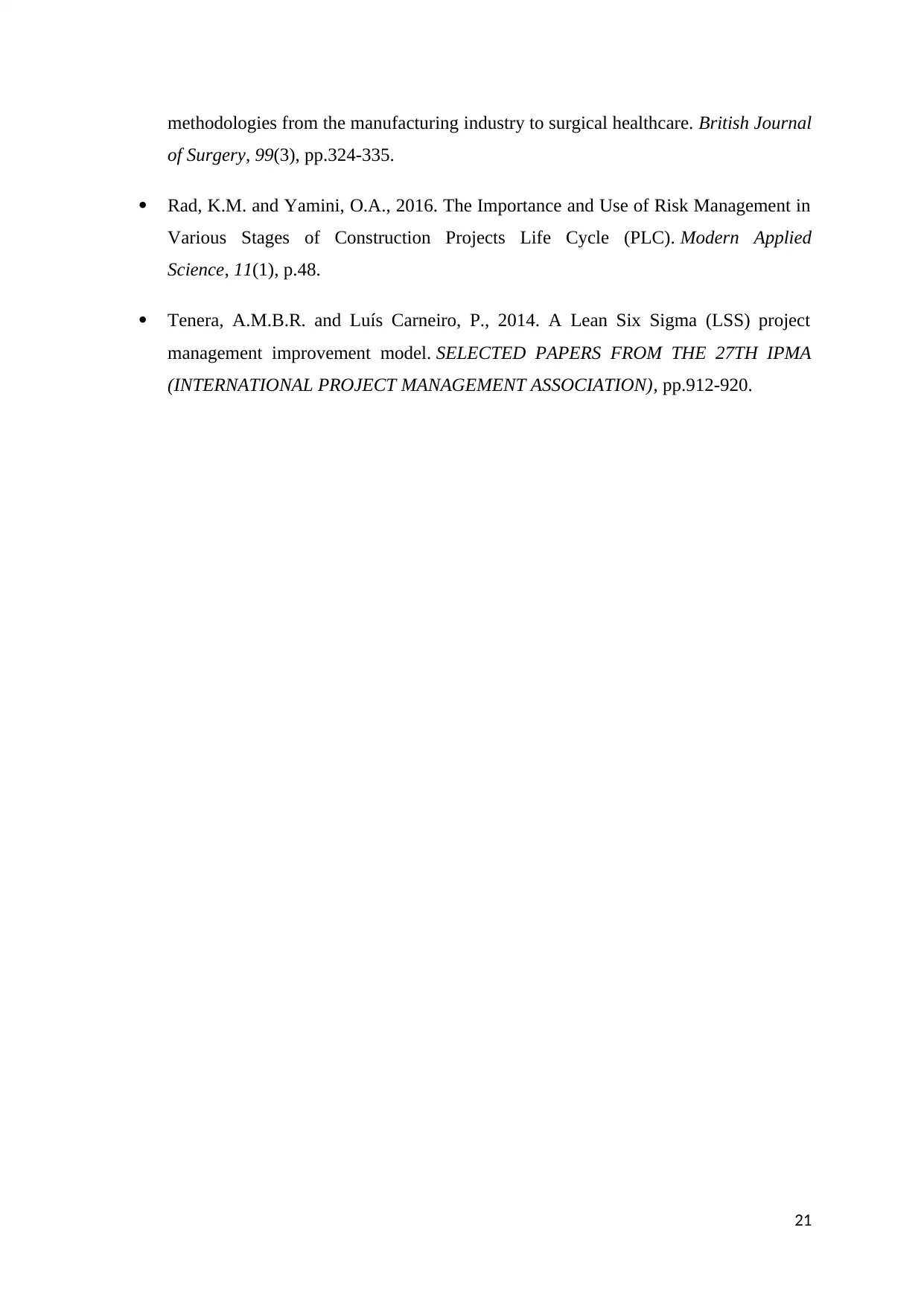
methodologies from the manufacturing industry to surgical healthcare. British Journal
of Surgery, 99(3), pp.324-335.
Rad, K.M. and Yamini, O.A., 2016. The Importance and Use of Risk Management in
Various Stages of Construction Projects Life Cycle (PLC). Modern Applied
Science, 11(1), p.48.
Tenera, A.M.B.R. and Luís Carneiro, P., 2014. A Lean Six Sigma (LSS) project
management improvement model. SELECTED PAPERS FROM THE 27TH IPMA
(INTERNATIONAL PROJECT MANAGEMENT ASSOCIATION), pp.912-920.
21
of Surgery, 99(3), pp.324-335.
Rad, K.M. and Yamini, O.A., 2016. The Importance and Use of Risk Management in
Various Stages of Construction Projects Life Cycle (PLC). Modern Applied
Science, 11(1), p.48.
Tenera, A.M.B.R. and Luís Carneiro, P., 2014. A Lean Six Sigma (LSS) project
management improvement model. SELECTED PAPERS FROM THE 27TH IPMA
(INTERNATIONAL PROJECT MANAGEMENT ASSOCIATION), pp.912-920.
21
1 out of 21
Related Documents
Your All-in-One AI-Powered Toolkit for Academic Success.
+13062052269
info@desklib.com
Available 24*7 on WhatsApp / Email
![[object Object]](/_next/static/media/star-bottom.7253800d.svg)
Unlock your academic potential
© 2024 | Zucol Services PVT LTD | All rights reserved.





